
The Ultimate Guide to Powerboat Engines and Propulsion Systems
As a passionate powerboat enthusiast, I have always been fascinated by the incredible power and speed that these vessels can achieve. One of the key factors behind their impressive performance is the engine and propulsion system they use.
In this ultimate guide, I will take you through everything you need to know about powerboat engines and propulsion systems, helping you unleash the true power of your vessel.
Types of powerboat engines – inboard, outboard, and sterndrive
Powerboat engines come in different types, each with its own advantages and considerations. The most common types are inboard, outboard, and sterndrive engines.
Inboard engines are located within the hull of the boat, providing better weight distribution and a quieter ride. Outboard engines, on the other hand, are mounted on the transom and offer easier maintenance and maneuverability. Sterndrive engines combine the benefits of both inboard and outboard engines, with the engine located inside the boat and the propulsion unit outside.
Understanding horsepower and torque in powerboat engines
When it comes to powerboat engines, horsepower and torque are the two key performance indicators that you need to understand.
Horsepower is a measure of the engine’s power output and determines how fast your boat can go. Torque, on the other hand, is the rotational force that the engine produces, allowing your boat to accelerate quickly and handle heavy loads.
It’s important to find the right balance between horsepower and torque to match your boating needs. A higher horsepower engine will give you greater top speed, while more torque will enhance your boat’s acceleration and towing capabilities.
Fuel options for powerboat engines – gasoline vs diesel
Choosing the right fuel option for your powerboat engine is an important decision that can impact both performance and maintenance.
Gasoline and diesel are the two main fuel options available. Gasoline engines are more common and generally easier to maintain. They provide good performance and instant power, making them ideal for speed-oriented powerboats.
engines, on the other hand, offer better fuel efficiency and durability. They are well-suited for long-distance cruising and larger powerboats that require more torque. Consider your boating needs and preferences to determine the most suitable fuel option for your powerboat.
Choosing the right propulsion system for your powerboat
The propulsion system is another crucial aspect of your powerboat’s performance. There are two main types of propulsion systems: propellers and jet drives.
Propellers are the traditional choice and are most commonly used in powerboats. They provide excellent efficiency and control, allowing you to fine-tune your boat’s performance.
Jet drives, on the other hand, use waterjet propulsion and offer superior maneuverability and shallow water capabilities. They are often found in smaller powerboats and are preferred for their safety features. Consider your boating style, location, and specific requirements when selecting the right propulsion system for your powerboat.
Maintenance tips for powerboat engines and propulsion systems
Proper maintenance is essential to ensure the longevity and optimal performance of your powerboat’s engine and propulsion system.
Regularly check the oil levels, filters, and belts to ensure they are in good condition. Keep an eye on the cooling system and flush it regularly to prevent overheating.
It’s important to follow the manufacturer’s recommended maintenance schedule, including oil changes, spark plug replacements, and fuel system inspections.
Additionally, make sure to clean the propellers or jet intake regularly to prevent any debris or fouling that could impact performance.
By following these maintenance tips, you can keep your powerboat’s engine and propulsion system in top shape and avoid any unexpected issues.
Upgrading your powerboat’s engine and propulsion system
If you’re looking to unleash even more power and performance from your powerboat, upgrading the engine and propulsion system can be an exciting option.
There are various upgrades available, ranging from swapping out the engine for a higher horsepower model to installing a performance propeller or jet impeller. However, before making any upgrades, it’s important to consider the compatibility and limitations of your boat’s hull and structure.
Consult with a professional or experienced mechanic to ensure that the upgrades are suitable for your powerboat and will provide the desired results. Upgrading your powerboat’s engine and propulsion system can take your boating experience to a whole new level.
Troubleshooting common issues with powerboat engines
While powerboat engines and propulsion systems are designed to be reliable, occasional issues may arise. It’s important to be familiar with common problems and troubleshooting techniques to address these issues promptly.
Some common issues include overheating, starting problems, fuel system issues, and electrical malfunctions. Regular maintenance and inspections can help prevent many of these issues, but it’s always good to be prepared.
Familiarize yourself with the owner’s manual and keep essential tools and spare parts onboard your powerboat. If you encounter a problem that you’re not comfortable fixing yourself, don’t hesitate to seek professional assistance.
Safety considerations for powerboat engines and propulsion systems
Safety should always be a top priority when operating a powerboat. When it comes to powerboat engines and propulsion systems, there are a few key safety considerations to keep in mind.
First and foremost, always follow the manufacturer’s guidelines and recommendations for safe operation and maintenance. Be cautious when handling fuel and ensure proper ventilation to avoid any potential fire hazards.
It’s also important to wear appropriate safety gear, such as life jackets and protective clothing, while operating the powerboat.
Regularly inspect the engine and propulsion system for any signs of wear or damage and address them promptly. By prioritizing safety, you can enjoy your powerboat experience with peace of mind.
Conclusion – maximizing the performance of your powerboat
In conclusion, understanding the different types of powerboat engines and propulsion systems is crucial for maximizing the performance of your powerboat.
Consider factors such as horsepower, torque, fuel options, and propulsion systems to find the right combination that suits your boating needs.
Regular maintenance and proper care will ensure the longevity and optimal performance of your powerboat’s engine and propulsion system. And if you’re looking for an extra boost in power and performance, explore the possibility of upgrading your engine and propulsion system.
Lastly, always prioritize safety and follow the recommended guidelines to enjoy your powerboat experience to the fullest.
If you’re ready to unleash the true power of your vessel, follow the tips and recommendations shared in this ultimate guide. Happy boating!

Welcome to Lake
Discover places to stay and unique experiences around the world.
- How It Works
Home - Blog - Powerboats 101: The Ultimate Guide to Speed and Thrills on The Water
Powerboats 101: The Ultimate Guide to Speed and Thrills on The Water

David Ciccarelli
February 2, 2024
In this article
Get started.

Types of Powerboats
When you’re out on the water, the kind of powerboat you choose can greatly influence your experience. Whether it’s for leisure or sport, these mechanical marvels are as varied in design and functionality as they are exciting.
If you’re all about velocity and performance, you’ll find speedboats produce an adrenaline rush that’s hard to match. Known for their powerful engines and sleek design, these boats are built for speed. Imagine feeling the wind whip through your hair as a twin-engine speedboat races across the water’s surface.
Ready for a fun-filled day with family and friends? Then the versatile bowrider is your go-to. With open bow areas, these boats welcome more passengers and facilitate a variety of water activities.
Cabin Cruisers
Experience luxury on the water with a cabin cruiser. These boats often include comfortable accommodations—think of them as your floating holiday home. With amenities for overnight stays, they cater to the cruiser who doesn’t want to leave the comforts of home behind. Cabin cruisers typically use robust inboard engines and technology to offer a smooth, steady ride for those long-distance ventures, as described by luxury boat manufacturer, Ocean Yachts.
Center Console Boats
Whether you’re an avid fisherman or enjoy casual trips around the bay, center console boats have become synonymous with versatility. With the helm positioned in the center of the boat, you get 360-degree access to the water, perfect for casting a line from any angle. Many center consoles are rigged with triple outboard engines, giving a reliable performance.
Key Features and Accessories
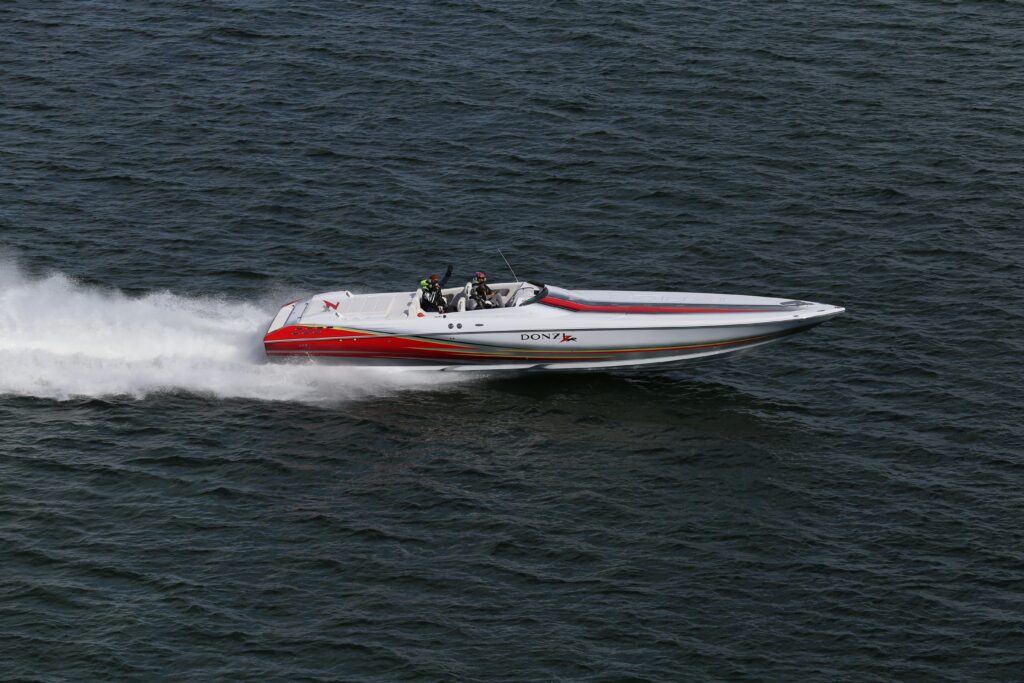
In the exhilarating world of powerboats, every enthusiast knows that it’s the advanced engines, sleek hull designs, cutting-edge navigation systems, and luxurious touches that distinguish the best vessels. Whether you’re out for performance or indulgence, let’s explore what sets a premium powerboat apart from the rest.
Engines and Horsepower
Have you ever felt the thrill of raw power as you throttle up? The heart of a powerboat is its engine, with horsepower (HP) ratings that can soar into the thousands for performance models. For instance, Formula Boats, known for their high-performance powerboats , equip their vessels with engines that can deliver upwards of 600 HP. High-powered engines ensure that propulsion and performance are maximized for those who crave speed and agility on the water.
Hull Design
Ever wondered why a powerboat cuts through the water like a knife through butter? Hull design is key , with deep-V designs commonly used for their ability to slice through waves and provide a smoother ride in rough conditions. The design isn’t just about performance; it significantly contributes to the vessel’s safety and stability.
Navigation and Electronics
Today’s powerboats are akin to technological marvels floating on water. The integration of high-tech navigation and electronics systems is essential for both safety and convenience. Touchscreen interfaces, GPS mapping, and radar can be found on state-of-the-art models, with technology like the Simrad GO9 XSE being an example of a top-tier fish finder with navigational competencies.
Comfort and Luxury
Lastly, who says you can’t be comfortable while zipping across the waves? Powerboats can be floating paradises with luxury and comfort rivaling high-end automobiles. Premium seating, ample storage, and amenities like air conditioning and heaters mean that your time of the water is as enjoyable as possible. For those who appreciate the finer things, accessory options such as the best boat grill from Magma or waterproof Bluetooth speakers enhance the experience—think concert hall acoustics at the mere push of a button.
Don’t you agree that knowing the ins and outs of these features will not only boost your boating knowledge but also influence your next purchase or upgrade? After all, it’s these details that can define your seafaring lifestyle!
Powerboat Brands and Manufacturers
When you’re exploring the world of speed and luxury on water, you’ll come across some standout names synonymous with quality and reliability. Let’s steer our course through some of the leading powerboat brands known for their exceptional performance boats, comfort, and style.
Yamaha Boats
Yamaha stands as a titan in the marine industry, offering a fleet of powerboats that blend performance and pleasure. With their jet propulsion systems, these boats are not only fun but also safe, as they come without external propellers. The Yamaha lineup includes models ranging from nimble jet boats to spacious luxury versions, where you can feel the thrill of the waves without compromising comfort.
Considered by many as a leader in the powerboat realm, Sea Ray crafts vessels that epitomize the balance between elegance and edge. Known for their sporty yachts and cruisers, Sea Ray’s models offer you a slice of heaven with their plush interiors and state-of-the-art amenities. It’s not just about the looks; these boats are engineered to perform, ensuring your time on the water is nothing short of extraordinary.
Boston Whaler
Praised for their unsinkable hulls, Boston Whaler has carved a niche for themselves in the powerboating world. This manufacturer is particular about safety and dependability without skimping on luxury. Their boats, often termed the “Legends of the Sea,” range from versatile center consoles to upscale cabin cruisers, giving you a trusted platform for any aquatic adventure.
Uncover the passion behind each model’s creation and set sail on your next voyage with a trusted builder. Whether you’re after adrenaline-filled water sports or serene yachting escapades, these brands have something tailored just for your experiences on the water.
Choosing the Right Powerboat

When you’re in the market for a powerboat, the sheer variety can be overwhelming. You want performance, luxury, and technology, all within your budget. Let’s slice through the waves and focus on what really matters for you and your nautical adventures.
Assessing Your Needs
What are you dreaming of when you think of a powerboat? Is it speeding across the bay, rods bending with the next big catch, or leisurely cruising with your family? Identify the primary use: fishing , family fun, or traveling long distances. Keep in mind, the choice you make here steers the rest of your decision-making process.
Budget Considerations
Be frank about your budget. A brand new speedboat can set you back a hefty sum, but remember, the initial price isn’t the whole story. The National Marine Manufacturers Association states that maintenance costs can be about 10% of the purchase price annually, so factor that in when you’re thrashing out the numbers.
Size and Maneuverability
Bigger isn’t always better. A compact powerboat can offer thrilling performance and easier handling , particularly in choppy waters. Conversely, a larger vessel may be necessary for stability and features when planning long-haul sea journeys. Consider what you’ll be comfortable maneuvering and where you’ll be doing most of your boating .
New vs. Used Boats
A shiny, new boat is tempting, but a gently used vessel could get you more bang for your buck. When considering new versus used, weigh the warranties and the potential for modern features against the depreciation and potential hidden costs of pre-owned models.
Maintenance and Care
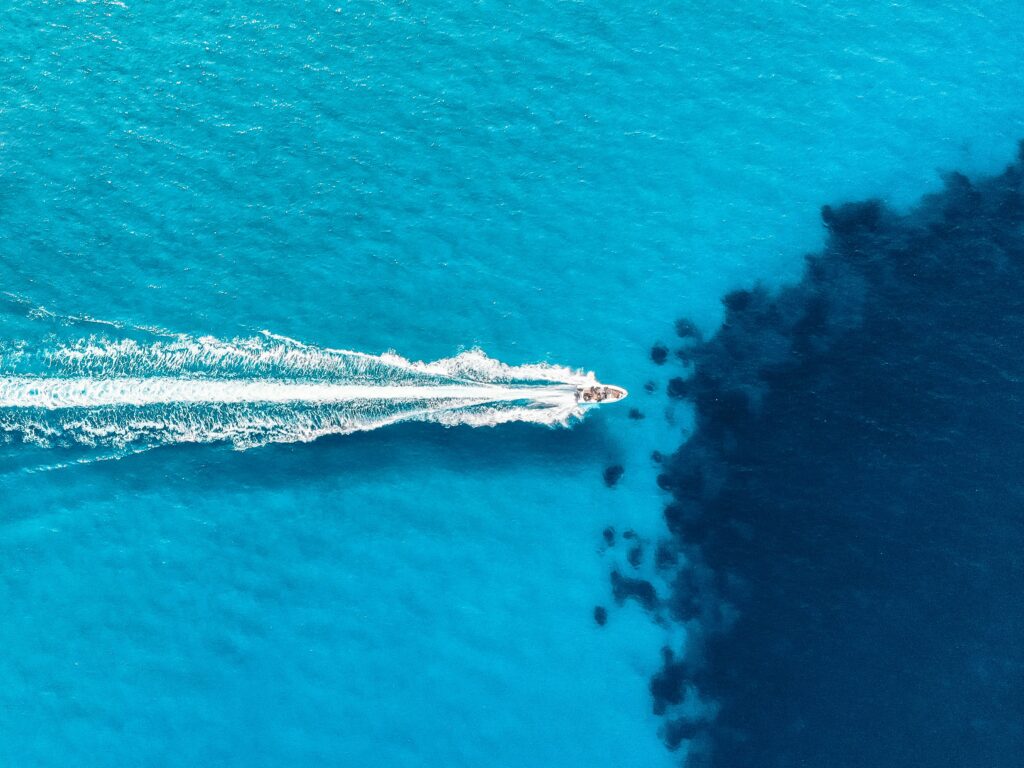
Taking care of your powerboat is crucial to ensuring peak performance, maximizing reliability, and guaranteeing safety during your watery adventures. Remember, a well-maintained powerboat can save you money in the long run on costly repairs and downtime.
Regular Maintenance
The heartbeat of your powerboat is its engine, and routine maintenance is your best defense against unexpected failures.
- Check the fuel tank : Always start with inspecting the fuel tank for any signs of contamination or leaks, as clean fuel is essential for a healthy engine. Did you know that water contamination in the fuel accounts for a significant percentage of marine engine issues ?
- Engine checks : Regular oil changes and filter replacements are like a health check-up for your powerboat, and adhering to the manufacturer’s schedule can also preserve the warranty.
- Battery care : Keep the battery terminals clean and check the charge before setting sail. A dead battery is a common headache you’d rather avoid.
Remember, each manufacturer has specific guidelines , so consult your owner’s manual for detailed instructions!
Cleaning and Storage
A clean powerboat isn’t just about good looks—it’s about ensuring longevity and maintaining value.
- After each outing , rinse your powerboat to remove salt, algae, and other abrasive materials. Boats.com suggests using a light brush and mild soap for most cleaning tasks.
- Storage tips : When it’s time to dock for longer periods, proper storage conditions are essential to keep your powerboat safe from environmental damage. Keep it covered and, if possible, out of the water to prevent hull blisters and corrosion. Remember, a well-protected boat ensures that the safety measures you rely on are always in order.
Ultimately, maintaining and caring for your powerboat is a journey, not a destination. It’s about keeping you, your passengers, and your investment safe. So, grab your mild soap and maintenance checklist, roll up your sleeves and give your powerboat the love it deserves!
Safety and Regulations
When you set out on your powerboat, it’s crucial to keep a few things in mind: your safety, the safety of your passengers, and staying compliant with rules and regulations. Let’s not skim over these details, as they could mean the difference between a fantastic day on the water and an unpleasant run-in with the authorities—or worse, an accident.
Powerboat Safety Essentials
Before throttling up your speed machine, let’s talk about what you should have on board to ensure everyone’s safety. Don’t forget, this isn’t just good sense—it’s the law.
- Life Jackets : First and foremost, you need a USCG-approved life jacket for each person aboard. They aren’t just floaty fashion statements; they save lives.
- Communication Device : An efficient sound-producing device is mandatory for powerboats less than 65.6 feet. In simple terms, make sure you have a way to signal for help if the unexpected occurs.
- Fire Extinguishers : Fires can happen, even on water! Ensure you have the right type of fire extinguisher on board to handle any flames that dare disturb your peaceful voyage.
- Navigation Lights : If you’re out past sunset or before sunrise, proper lighting is not optional. It’s about seeing and being seen.
Boating Regulations
Regulations are like the buoys of boating—they guide you safely and keep you in line. What do you need to know to stay legal and enjoy your time without hassle?
- Licensing : Depending on your location, you may need a boater’s license . Think of it as a driver’s license for the water. Make sure yours is current and recognized by the waters you’ll be cruising.
- Speed Limits : Yes, they exist on the water too! Not every area is a free-for-all. Certain zones will have restrictions especially near marinas, swimming areas, or ecologically sensitive regions.
- Comfort : We’re not just talking plush seating—a comfortable outing also means having enough space for each passenger and not overloading your boat beyond what’s considered safe capacity.
- State-Specific Regulations : You’ve got your federal laws , and then you’ve got your state quirks. Some states have specific rules that are unique to their waters, so do your homework!
Remember, each powerboat is a unique vessel and recommends it’s own maintenance rituals that can affect your safety and adherence to regulations. Brand names like Sea Ray and Boston Whaler are known for crafting their boats with safety and comfort in mind.
By taking the time to familiarize yourself with these safety measures and regulations, you’re not just preparing for a safe trip; you’re ensuring that your time on the water is as enjoyable and stress-free as possible. Now, who’s ready to make some waves, within limits, of course?
FAQs (Frequently Asked Questions)
What speeds can I expect from a powerboat? Your powerboat’s speed can vary widely based on factors like size, design, and engine power. Generally, a leisure powerboat might cruise around 20 knots, while high-performance models could soar past 50 knots!
Any safety tips for first-time powerboat users? Absolutely! Always wear a life jacket, check the weather before heading out, and ensure your boat has all necessary safety equipment. Familiarize yourself with the operation and emergency procedures—safety first!
Is fishing viable with any powerboat? While not all powerboats are designed for fishing, many are very suitable. Features like rod holders and live wells turn a standard powerboat into a fishing-friendly vessel.
Remember, the joy of boating comes with responsibility. By keeping these FAQs in mind, you’re all set for a fantastic time on the water. Happy boating!

administrator
David Ciccarelli, is the Founder and CEO of Lake. He is based in Toronto, Canada, and is an expert in management, business administration, strategy, product development, and customer experience. His educational achievements include the Owner President Management Program at Harvard Business School (2019-2022) and the QuantumShift Program at Ivey Business School in 2017, aimed at CEOs of growing businesses.
Related Posts

October 3, 2023
Boating: Your 10-Step Guide to Driving a Boat Safely
Boating is a fantastic way to take advantage of the great outdoors and create unforgettabl...
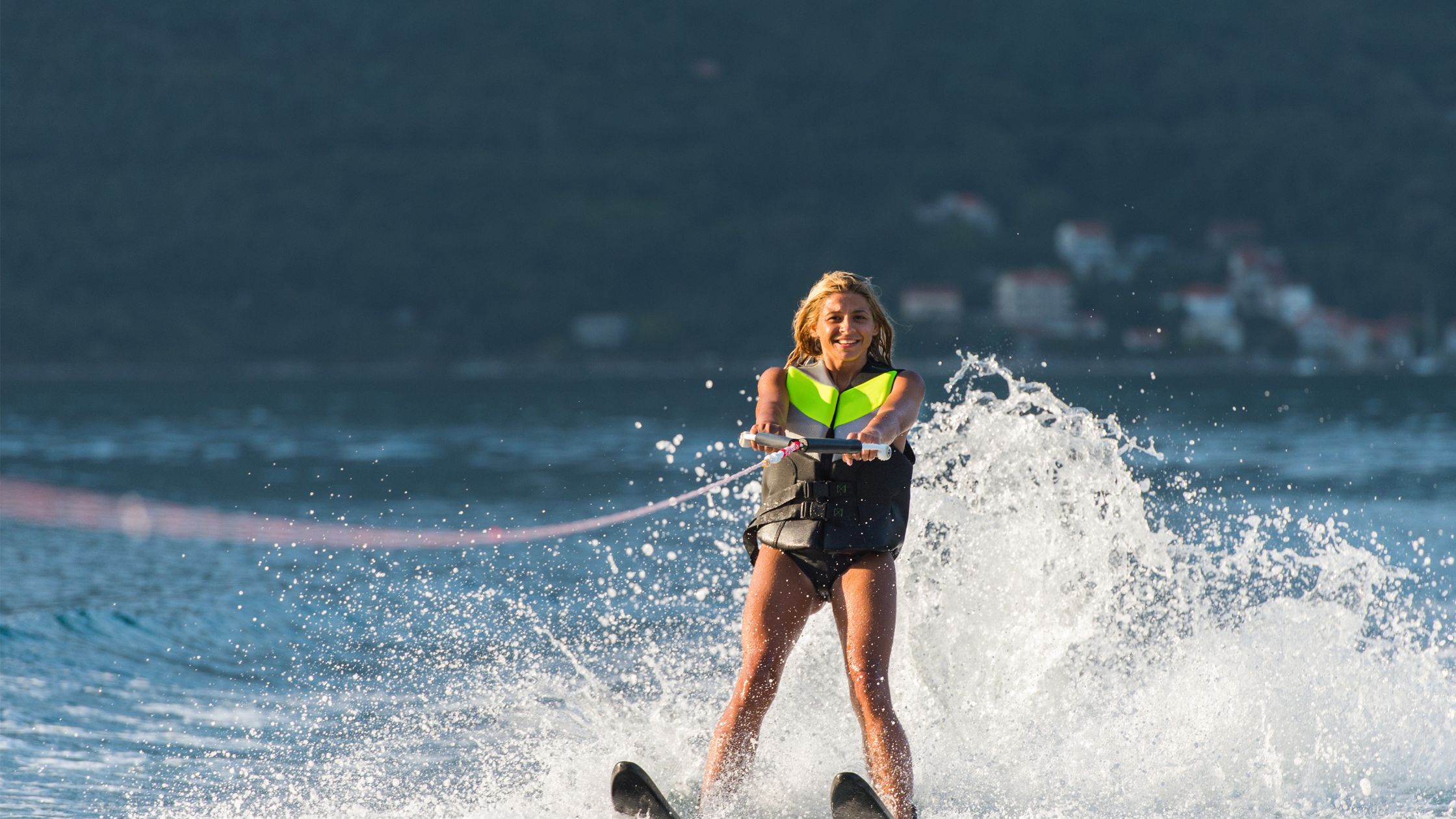
October 4, 2023
Water Skiing Essentials: Tips and Tricks for a Thrilling Experience
Water skiing is an exhilarating surface water sport where individuals ride on one or two s...
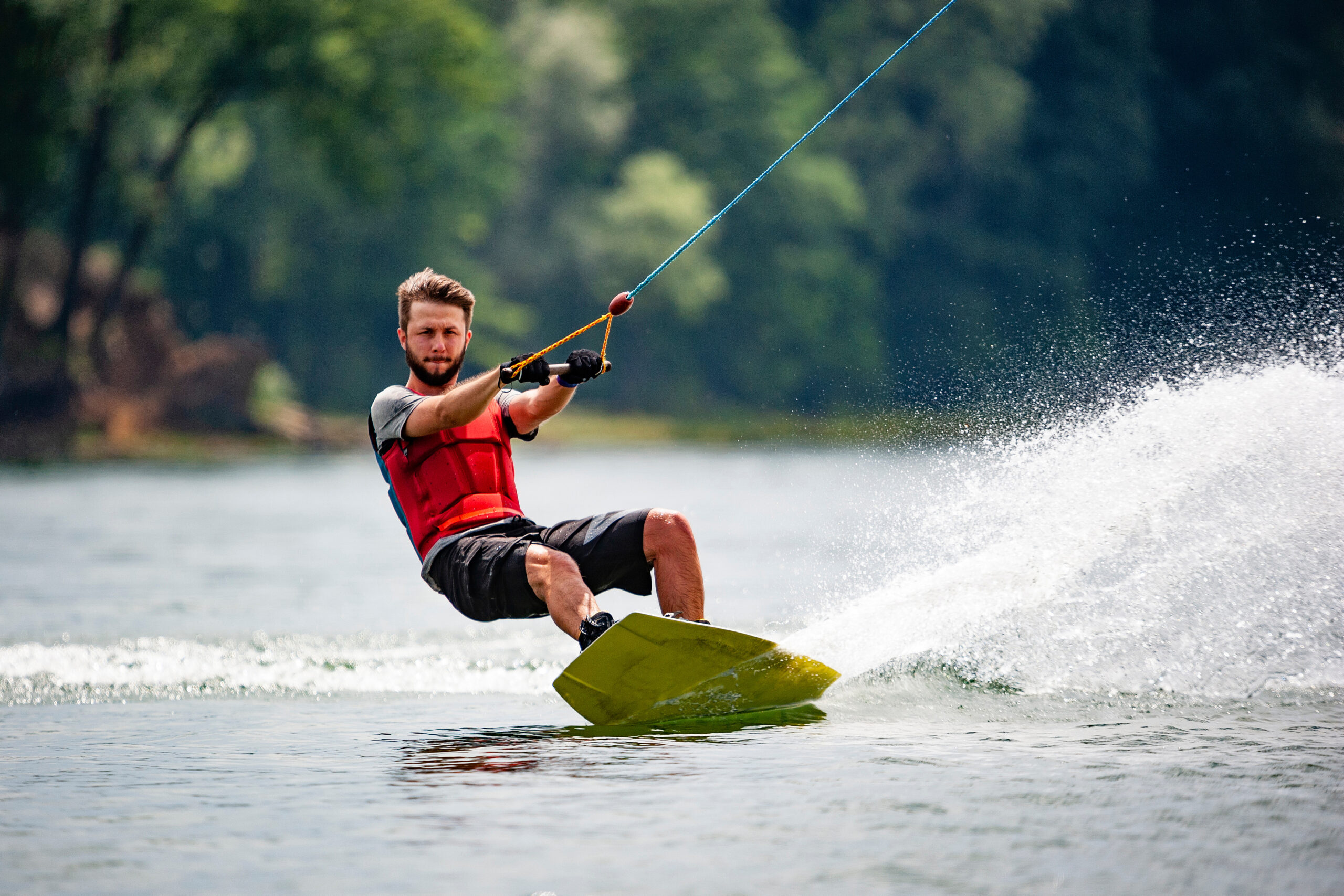
Wakeboarding Fun: Tips and Techniques for Every Skill Level
Wakeboarding is a thrilling water sport that has captured the interest of adrenaline seeke...
Don't have an account yet? Register
Already have an account? Sign In
Reset Password
Please enter your username or email address, you will receive a link to create a new password via email.

Service Locator
- Angler Endorsement
- Boat Towing Coverage
- Mechanical Breakdown
- Insurance Requirements in Mexico
- Agreed Hull Value
- Actual Cash Value
- Liability Only
- Insurance Payment Options
- Claims Information
- Towing Service Agreement
- Membership Plans
- Boat Show Tickets
- BoatUS Boats For Sale
- Membership Payment Options
- Consumer Affairs
- Boat Documentation Requirements
- Installation Instructions
- Shipping & Handling Information
- Contact Boat Lettering
- End User Agreement
- Frequently Asked Questions
- Vessel Documentation
- BoatUS Foundation
- Government Affairs
- Powercruisers
- Buying & Selling Advice
- Maintenance
- Tow Vehicles
- Make & Create
- Makeovers & Refitting
- Accessories
- Electronics
- Skills, Tips, Tools
- Spring Preparation
- Winterization
- Boaters’ Rights
- Environment & Clean Water
- Boat Safety
- Navigational Hazards
- Personal Safety
- Batteries & Onboard Power
- Motors, Engines, Propulsion
- Best Day on the Water
- Books & Movies
- Communication & Etiquette
- Contests & Sweepstakes
- Colleges & Tech Schools
- Food, Drink, Entertainment
- New To Boating
- Travel & Destinations
- Watersports
- Anchors & Anchoring
- Boat Handling
Types of Powerboats and Their Uses
Advertisement
What Is An Outboard Runabout?
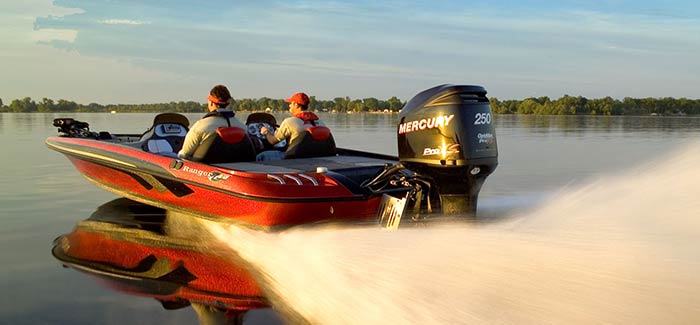
Bass boats are generally 14' to 23', and typically used for freshwater fishing. They have low freeboard and a V hull. They are specialized for bass fishing on inland lakes and rivers. Due to the special gear, high horsepower outboards and trolling motors they are a relatively high price point.
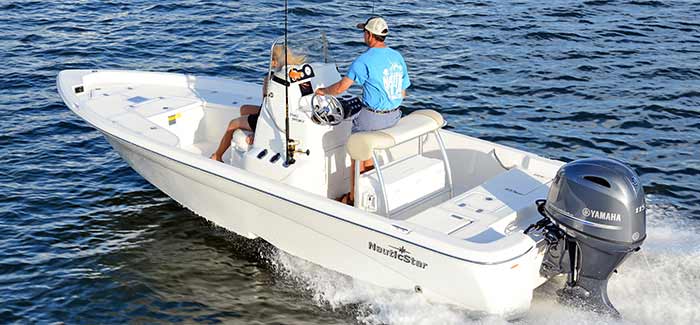
Bay boats have a low profile. They are designed for use in shallow waters of large shallow bays, estuaries or near shore. Bay boats are 18'–24' in length and are fiberglass because they are used in salt or brackish waters. They have more freeboard than a flats boat.
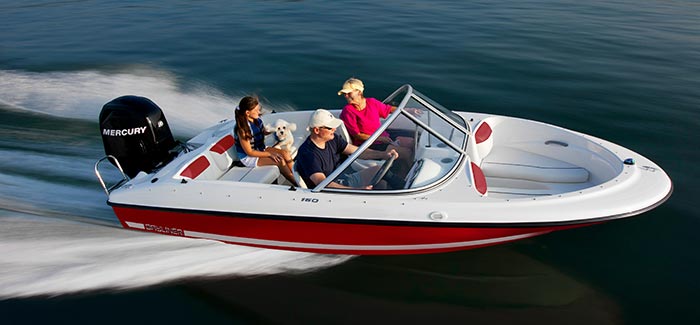
A bowrider has an open bow area designed for extra seats forward of the helm. Bowriders are usually 17'–30'. They are powered by either stern drive or outboard engines. Considered a family boat and can be used for fishing and water sports. A good choice for those new to boating.
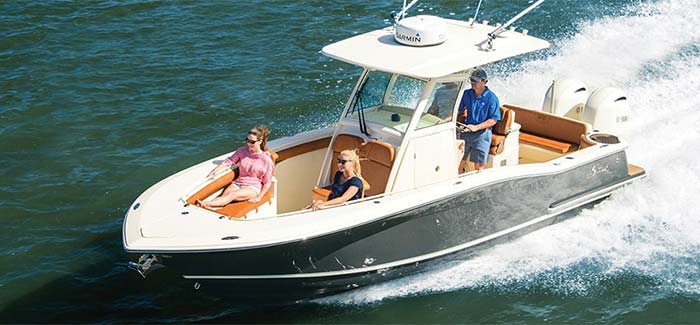
Center Console
Center console boats are from 13'–45'. They are so-named because their helm is on a console in the center of the boat. Like walkarounds, the open hull helps anglers walk from bow to stern without having to navigate around the console. Most use outboard motors for propulsion and the larger size boats are suited for offshore fishing.
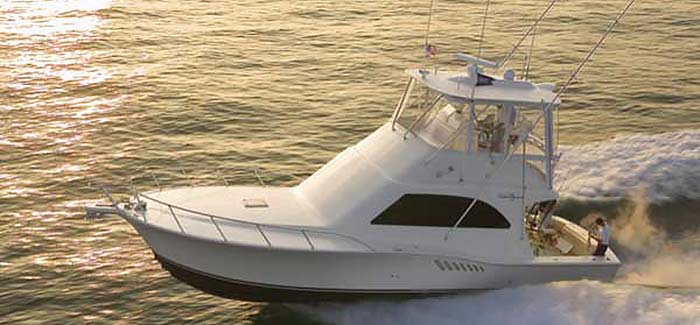
Convertible Fishing Boat
Convertibles are 35 foot and greater boats suited for offshore fishing and cruising. They have large cabins, galleys and berths and are perfect for pleasure cruises and offshore fishing. The flybridge with elevated helm helps to spot flotsam or fish. They have a large fishing deck aft.
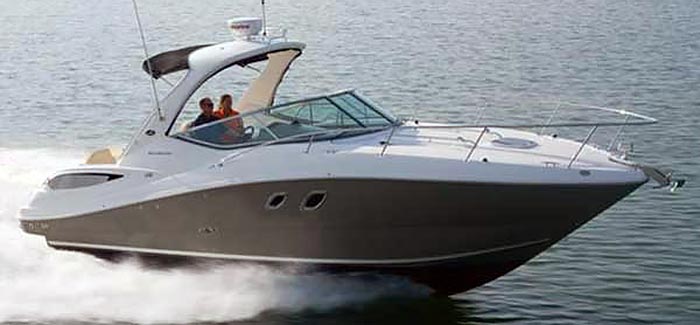
Cruisers are from 21'–45' in length and have a cabin in the bow of the boat. Cruiser cabins are designed for an overnight stay and are typically large enough for a small galley, several berths and an enclosed head.
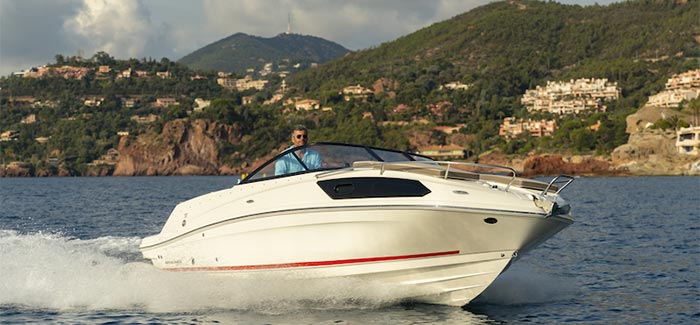
Cuddy Cabin
Cuddy cabin boats have a small cabin for storage or a small seating area. They may accommodate a berth and or head. They are usually about 22–30 feet in length.
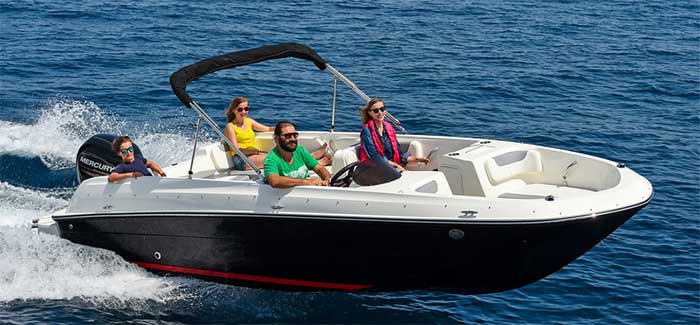
Deck boats have a wide beam and feature a V-shaped hull which offers more performance than a pontoon boat. Featuring an open deck with plenty of seating for parties or family. Used for swimming and water sports. They are outboard or stern drive powered and can be aluminum or fiberglass. These boat are about 25–35 feet long.
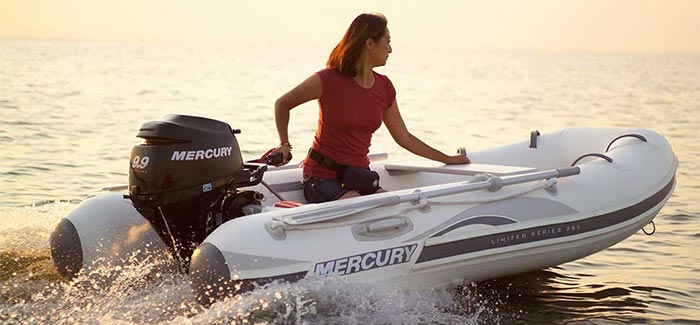
A dinghy is a small boat, usually 7–12 feet in length. They are usually powered by oars, small outboards, or sails. Often carried or towed by a larger boat for going ashore. Low cost and an excellent choice for those new to boating.
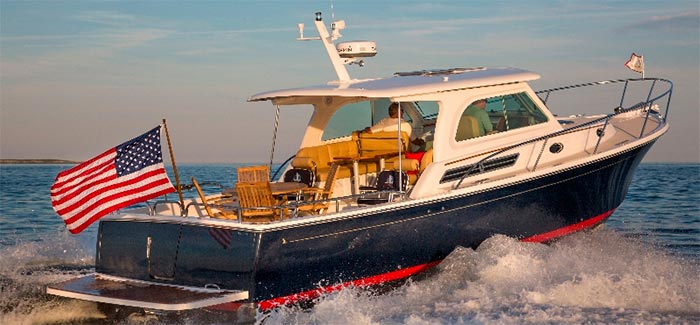
Downeast Cruiser
These boats are native to coastal New England. Also called lobster boats, they are built for offshore cruising and fishing. They have a cabin with berths and a head and dining area.
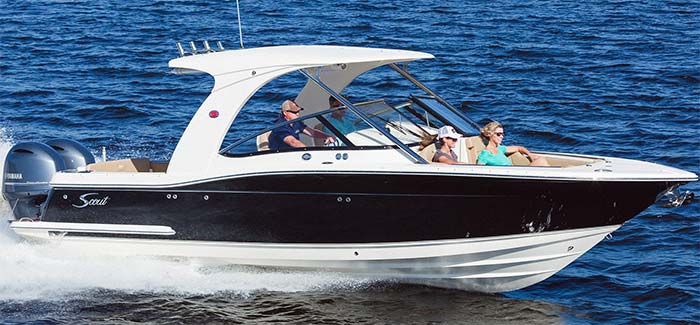
Dual Console
Dual Console boats have two dashboards and windshieldswith space to walk between them for allowing access to the bow area for seating and/or fishing. Lengths run 16–30 feet.
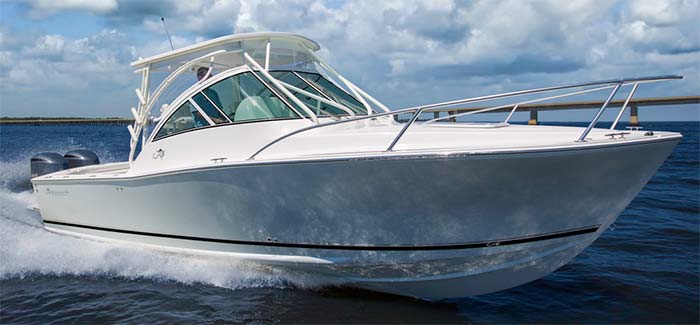
Express Fisherman
The Express Fisherman is designed for high speeds to get to offshore fishing spots in a hurry. They are rigged for offshore fishing. They have large open cockpits and fish fighting areas aft. They usually have limited cruising accommodations but can provide overnight shelter.
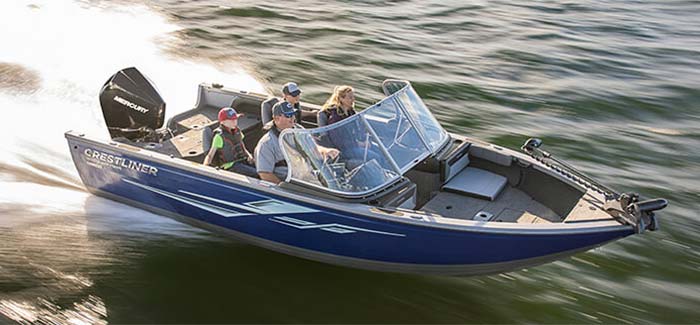
Fish 'n Ski Boat
Fish 'n Ski boats are used for fishing or skiing. These are family boats. They have accessories for each application. They feature comfortable seating and offer livewells and tie downs for rods and have removable, elevated tow bars and ski lockers. They are usually 16–24 feet in length.
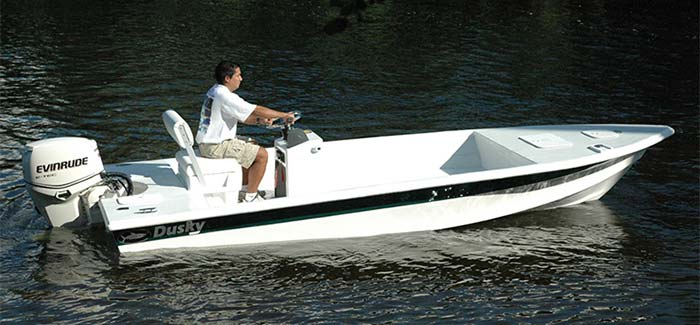
Flats Boats range from 14 feet to 18 feet and are specifically designed to navigate shallow waters needing extremely shallow drafts. A push pole is used to navigate the shallow water.
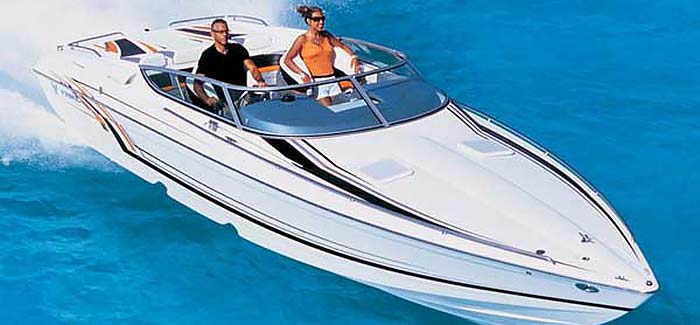
High Performance Boat
Performance powerboats are built for speed, featuring narrow beam, steep deadrise, and high power to weight ratios. They have Spartan cabins. Cockpits seat 2–6 passengers. Powered by high horsepower outboards, stern drives or surface drives, these boats are carefully designed to be fast, light and strong, ideal for racing or fast cruising. They range from 25–60 feet in length.
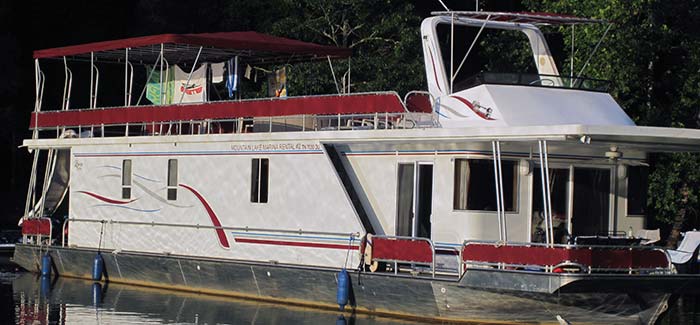
As the name implies houseboats are floating houses. They are either outboard or inboard propelled and range from 25 to 150 feet in length. Just like a house they have full kitchens, bedrooms and living and dining areas. They are the ultimate family boat. They are generally found on quieter bodies of water since they have low freeboards and are built on a barge-like hull.
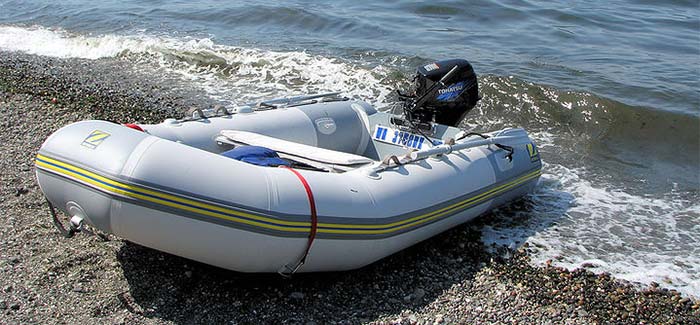
Inflatable Boat
Usually 6'–14' in length and have inflatable tubes for their sides. The floor is flexible or made rigid using plywood or aluminum floorboards depending on the size. Outboard motors can be used on the rigid transom. They deflate and are easy to transport or store. Used as dinghies on larger boats. A good choice for those new to boating.
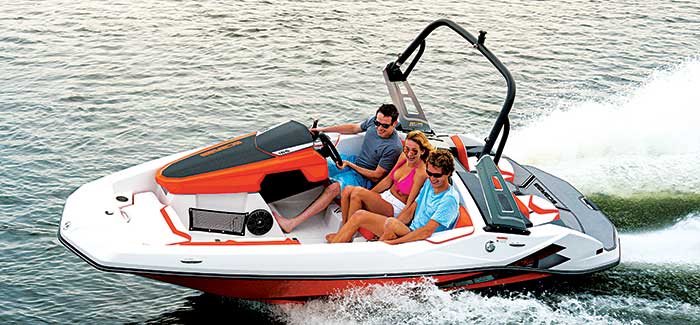
Jet Boats have single or multiple jet drives instead of a propeller for propulsion. They are very maneuverable. These smaller boats (14–24 feet) are generally used for water sports and getting into shallow waters.
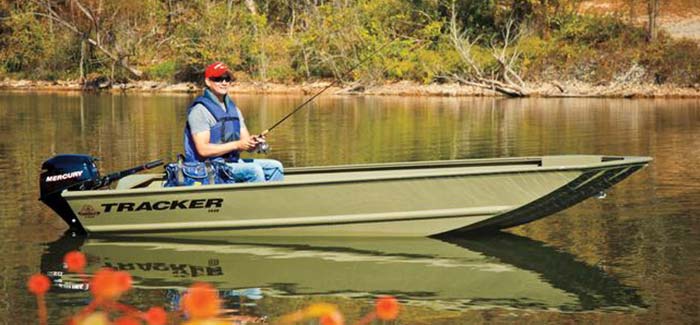
Jon boats are small utility craft primarily used for boating in shallow water. They range from 10 to 18 feet in length. They can be made of aluminum or fiberglass. They are inexpensive and a good choice for the novice boater.
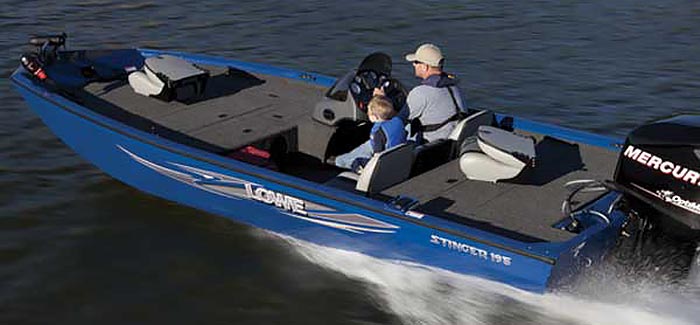
Multi-species Boat
Multi-species boats are 17–23 feet in length. They are made of fiberglass or aluminum. They are designed to travel in rougher water than bass boats. As the name implies, these boats are made for fishing a variety of different fish in all types of water.
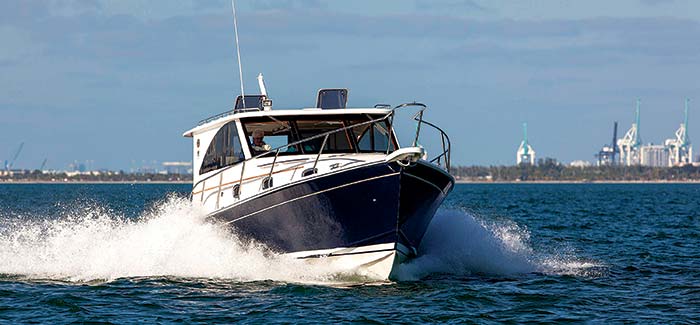
Pilothouse Boat
Featuring a fully enclosed pilot house, these boats are built to ride rougher seas while keeping helmsman high and dry. They are powered by outboards, stern drives or inboards. They are popular for cruising and many types of fishing. They usually have a berth and a head. They are usually 20–35 feet in length.
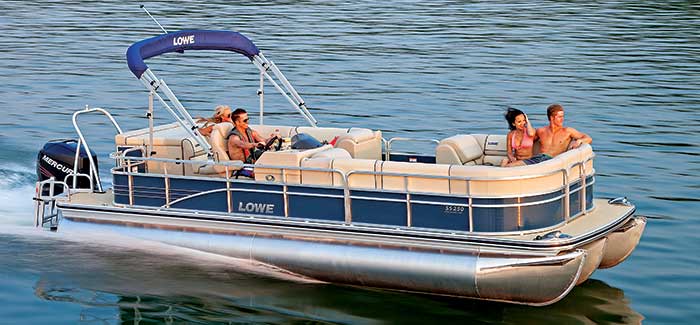
Pontoon Boat
Pontoon boats have 2 or 3 aluminum tubes that support a broad platform. They have shallow drafts and are very stable. They are usually found on inland lakes and rivers and other small bodies of water. Used for cruising, fishing and water sports. Powered by an outboard or stern-drive. Lengths from 15–30 feet.
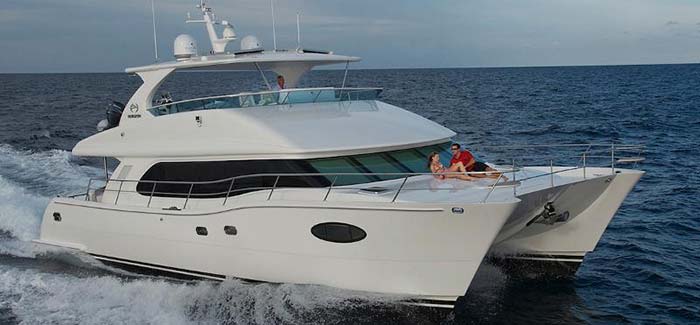
Power Catamaran
These dual-hull boats are generally used for offshore fishing. They are more rugged, provide a more stable ride, faster speeds and better fuel economy than mono-hulls. They are 25–40 feet in length.
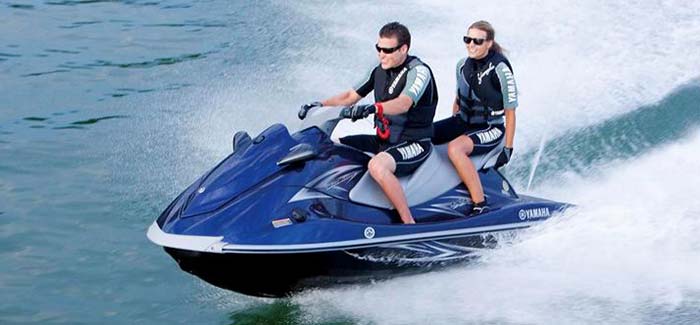
PWC (Personal Watercraft)
Entry level boats that are fun to drive and economical to buy. They come in lengths from 9–14 feet. They are usually built for 1 or 2 people but larger, more powerful models can seat up to 4. They are powered by jet drive.
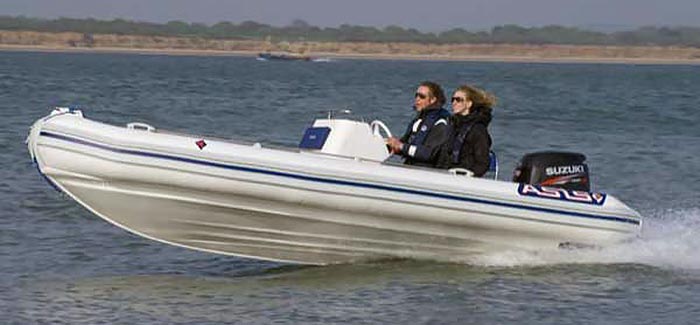
Rigid Inflatable
RIBs (rigid inflatable boat)s have a fiberglass or aluminum hull attached to inflatable outer tubes. Outboard motors are used on the transom for power. RIBs are usually faster, larger, and can carry more weight than flexible floored inflatables. They also come in larger sizes.
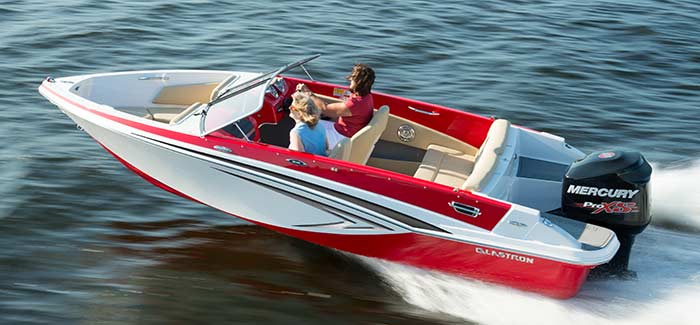
Many boats are called runabouts. Generally a runabout is defined as a small powerboat somewhere in the 14–24 foot range. They are usually powered by an outboard or stern-drive engine. They are a multipurpose boat suitable for water sports, cruising and fishing.
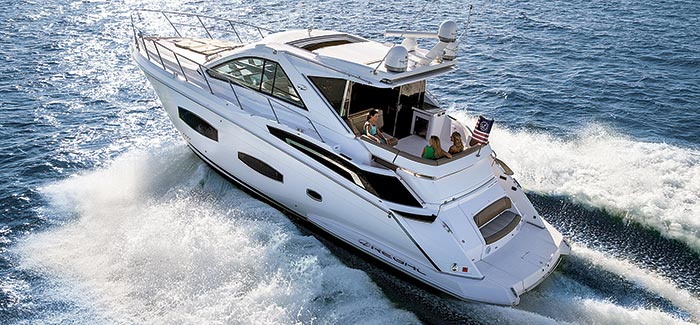
Sedan Bridge Boat
Intended for extended cruising with accommodations down below to suit long stays on the water. They range from about 35–65 feet. The bridge positions the helmsman high above the water allowing for great visibility.
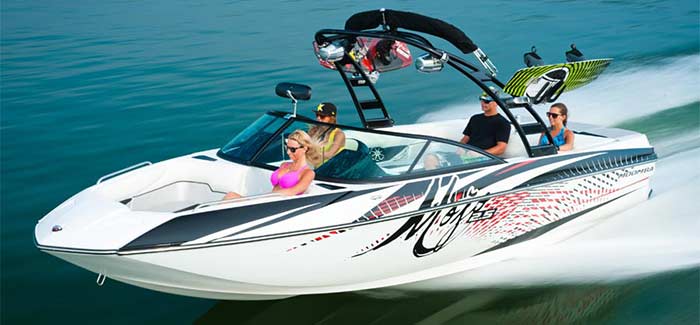
Ski and Wakeboard Boat
These boats are designed specifically for water sports. They can be ballasted for producing higher wakes for trick skiing and waterboarding. They are also great for pulling inflatable tubes.
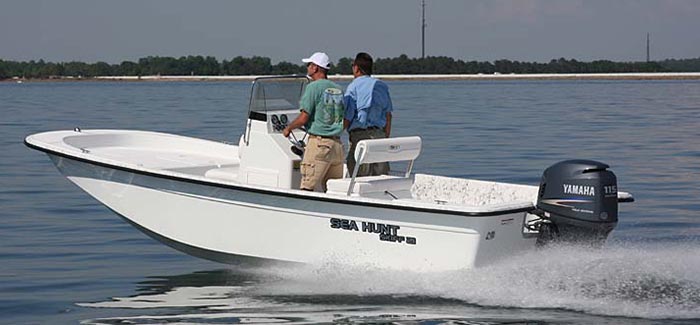
The skiff is similar to a Jon boat. They are another entry level boat. They are especially good for boating in shallow water. The can have flat or cathedral shaped hulls. Many have a console to steer from.
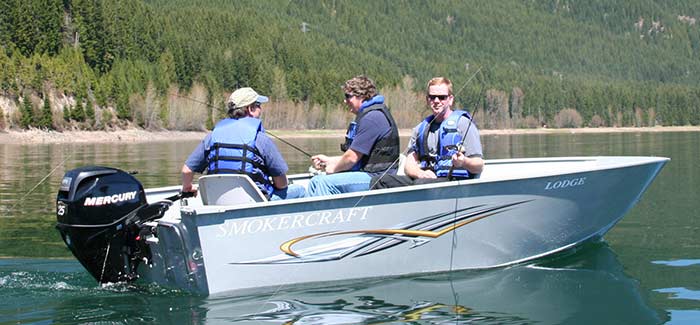
Utility Boat
Utility boats are made for tough use. Generally made of aluminum with outboard power and range from 12–20 feet. Used for fishing or as workboats. Relatively low cost to maintain and a good choice for the novice boater.
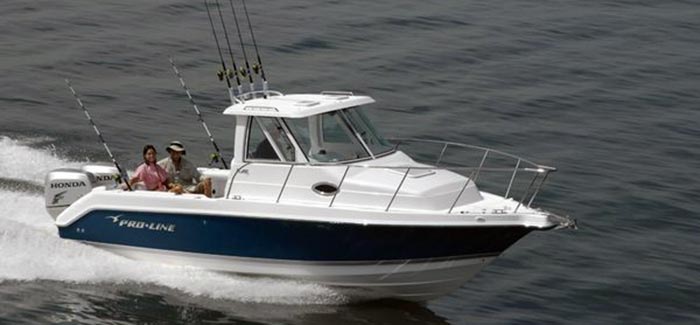
Walkarounds
Walkarounds allow an angler to walk around the cabin. They are generally 20–30 feet in length. They are usually found on larger bodies of water and can be powered by an outboard, Inboard/outboard or inboard engine.
Related Articles
The truth about ceramic coatings for boats.
Our editor investigates the marketing claims of consumer-grade ceramic coatings.
Fine-Tune Your Side Scan Fishfinder
Take your side-scanning fishfinder off auto mode, and you’ll be spotting your prey from afar in no time
DIY Boat Foam Decking
Closed-cell foam flooring helps make boating more comfortable. Here’s how to install it on your vessel
Click to explore related articles
BoatUS Editors
Contributor, BoatUS Magazine
Award-winning BoatUS Magazine is the official publication of Boat Owners Association of The United States. The magazine provides boating skills, DIY maintenance, safety, news and more from top experts.
BoatUS Magazine Is A Benefit Of BoatUS Membership
Membership Benefits Include:
Subscription to the print version of BoatUS Magazine
4% back on purchases from West Marine stores or online at WestMarine.com
Discounts on fuel, transient slips, repairs and more at over 1,200 businesses
Deals on cruises, charters, car rentals, hotel stays and more…
All for only $25/year!
We use cookies to enhance your visit to our website and to improve your experience. By continuing to use our website, you’re agreeing to our cookie policy.
- Build A Boat
- Find A Dealer

- How Much Horsepower Do I Need for My Boat?
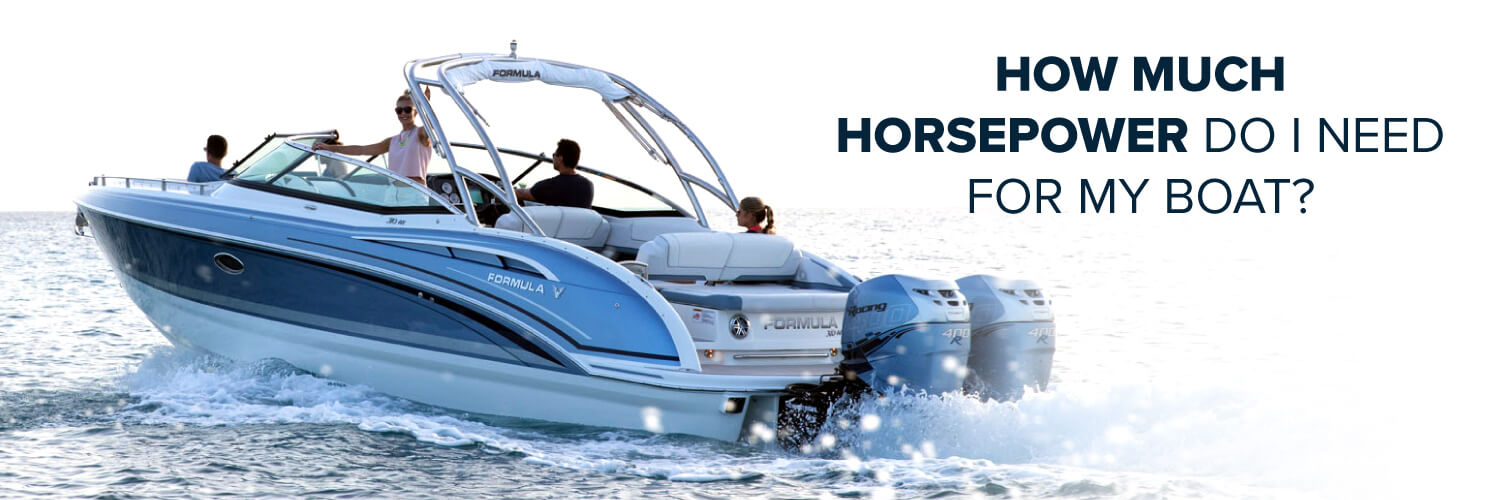
If you’ve been searching for a boat to purchase, or have reached the point at which you’d like to get a new engine, chances are you’ve asked the question, “How much horsepower do I need for my boat?” While the individual concerns may be different — wanting to make sure there’s enough horsepower or not too much horsepower — it’s a question many people who are interested in purchasing a new boat ask.
Sometimes, the follow-up question is, “Is it illegal to overpower a boat?” Whether you’ve been asking yourself one of these questions, or are just curious about how horsepower can affect the cost of fuel and insurance, we’ve gathered several pieces of information to educate you on horsepower. Through reading this information, you’ll be able to learn more about where it came from, how it’s calculated, how to determine the amount you need and the dangers that come with having too much.
What Is Boat Horsepower?
Horsepower is defined as a unit of power equal to 550 foot-pounds per second used to measure the power of an engine. Today, it applies to boat and auto engines, but its original use was to describe the power of a steam engine. In the late 1700s, a Scottish engineer named James Watt invented the first steam engine, which improved on a design pioneered by Thomas Newcomen in 1712 . It was a big deal. This new steam engine could do the same amount of work as the former Newcomen engine, but used only one-quarter of the fuel.
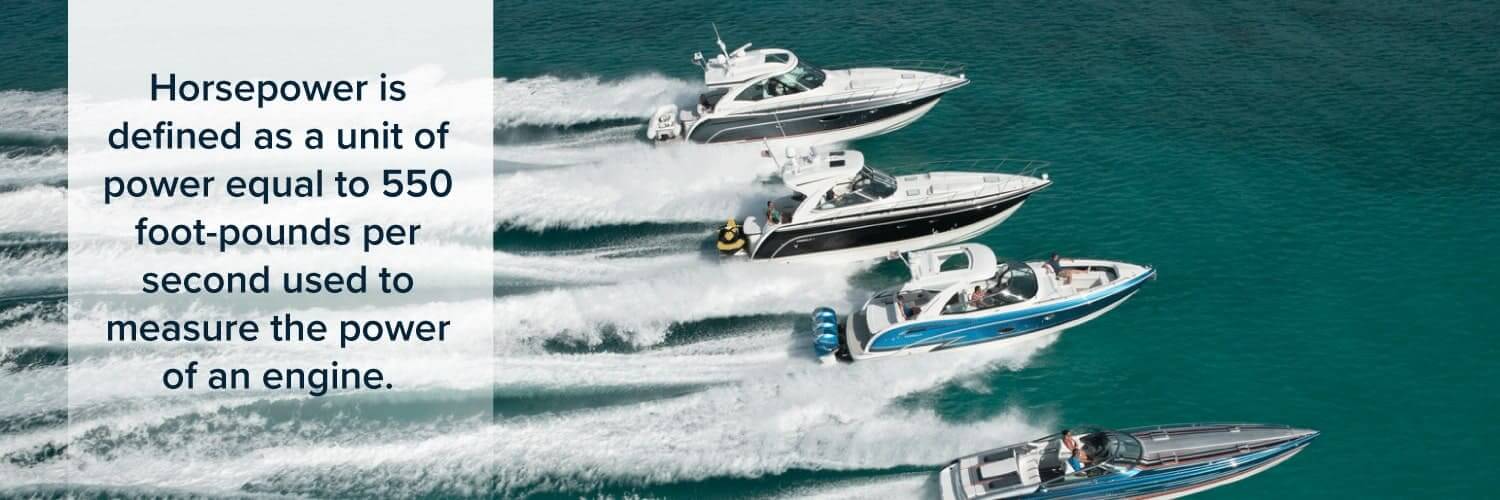
Unfortunately, comparing the steam engine to the Newcomen engine wasn’t effective marketing, as most of the population was still using horses for mechanical work. To market his new product to this audience, Watt knew he had to come up with a way to compare the work of horses to the work of his invention. Through his experiments, he determined one horse could do about 33,000 foot-pounds of work in one minute — meaning a horse could lift a 33,000-pound weight one foot in one minute. Therefore, he defined one horsepower as 33,000 foot-pounds of work per minute — or 550 foot-pounds per second.
There were a few flaws with this new measurement — the biggest being the assumption that a horse could continue to work at that consistent rate instead of tiring out. However, Watt didn’t let that fact bother him, and it didn’t bother his customers, either. Comparing the power of a horse to the power of a steam engine showed Watt’s steam engine could do the work of five horses, and it went on to become an integral part of the Industrial Revolution.
How Is Boat Horsepower Calculated?
The relevance of horsepower, the measurement of 550 foot-pounds per second, didn’t stop with the Industrial Revolution. The measurement of horsepower was converted into other units of measurement. For example, other experiments determined one horsepower equals 746 watts of energy. In other words, if you put a one-horsepower horse on a treadmill, it would be able to operate a generator producing 746 watts. Engineers also did calculations to relate horsepower to torque, which is especially important for boat engines.
Torque is easiest to explain through an example. Imagine you have a large socket wrench with a two-foot handle. You apply 50 pounds of force to that handle — when you do that, you’re applying a torque or turning force of a total of 100 pound-feet to the bold. Keep in mind, with that calculation, you could get the same result — 100 pound-feet of torque — by applying one pound of force to a socket wrench with a 100-foot handle, or by applying 100 pounds of force to a socket wrench with a one-foot handle.
In an engine, torque produces power — so being able to relate it to horsepower is critical. A device called a dynamometer applies a load on the engine and then measures the amount of power it produces to determine torque. Marine dynamometers are available, too — taking into consideration boat operation by simulating on-the-water operation. Once the torque has been determined, you’re able to convert torque to horsepower by multiplying torque by revolutions per minute (rpm) and dividing that product by 5,252. The divisor, 5,252, comes from a series of calculations that convert rpm to radians per second.
Through using a dynamometer, you’ll be able to see the horsepower versus rpm values for the engine, which is especially important for calculating peak horsepower. Engines will have a point in rpm at which the power available from the engine has reached its maximum. This is known as peak horsepower — it’s often documented as “___ HP at ____ rpm.”
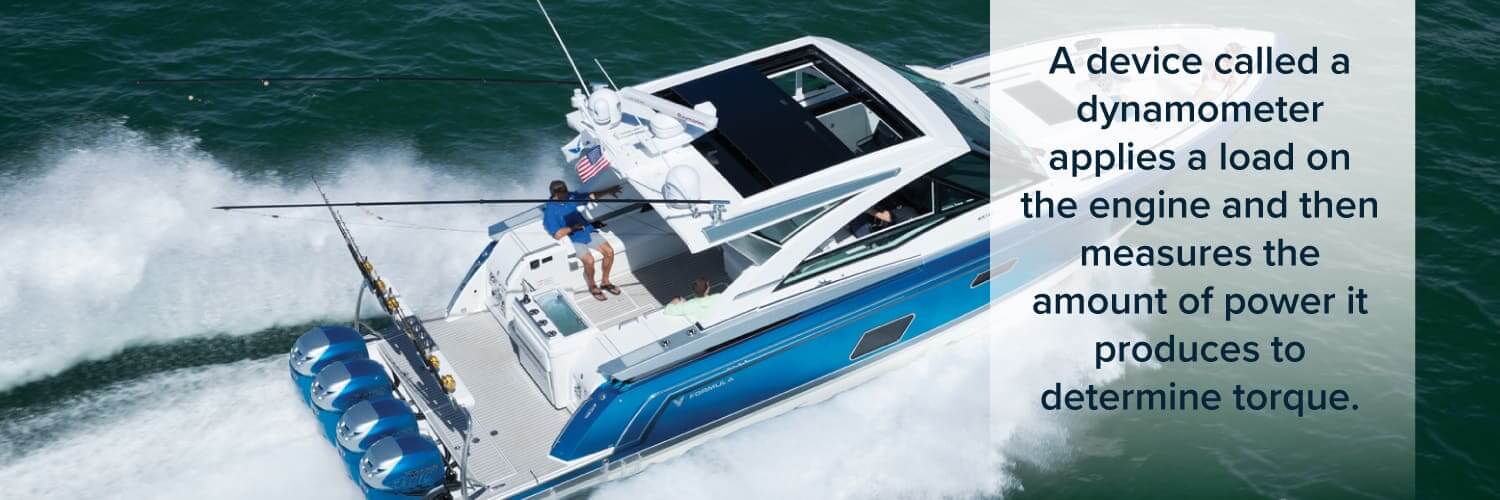

Determining How Much Horsepower You Need
Once you understand the history of horsepower and how that’s connected to the calculation we use today, it’s natural to wonder how much horsepower your boat needs. There are several factors to take into consideration when you’re determining how much horsepower you need — the manufacturer’s limits and recommendations, boat horsepower-to-weight ratio, fuel efficiency, use of the boat, number of people on the boat and an industry rule of thumb. Here are some things to consider in each of these areas to help you answer the question, “How much horsepower do I need for my boat?”
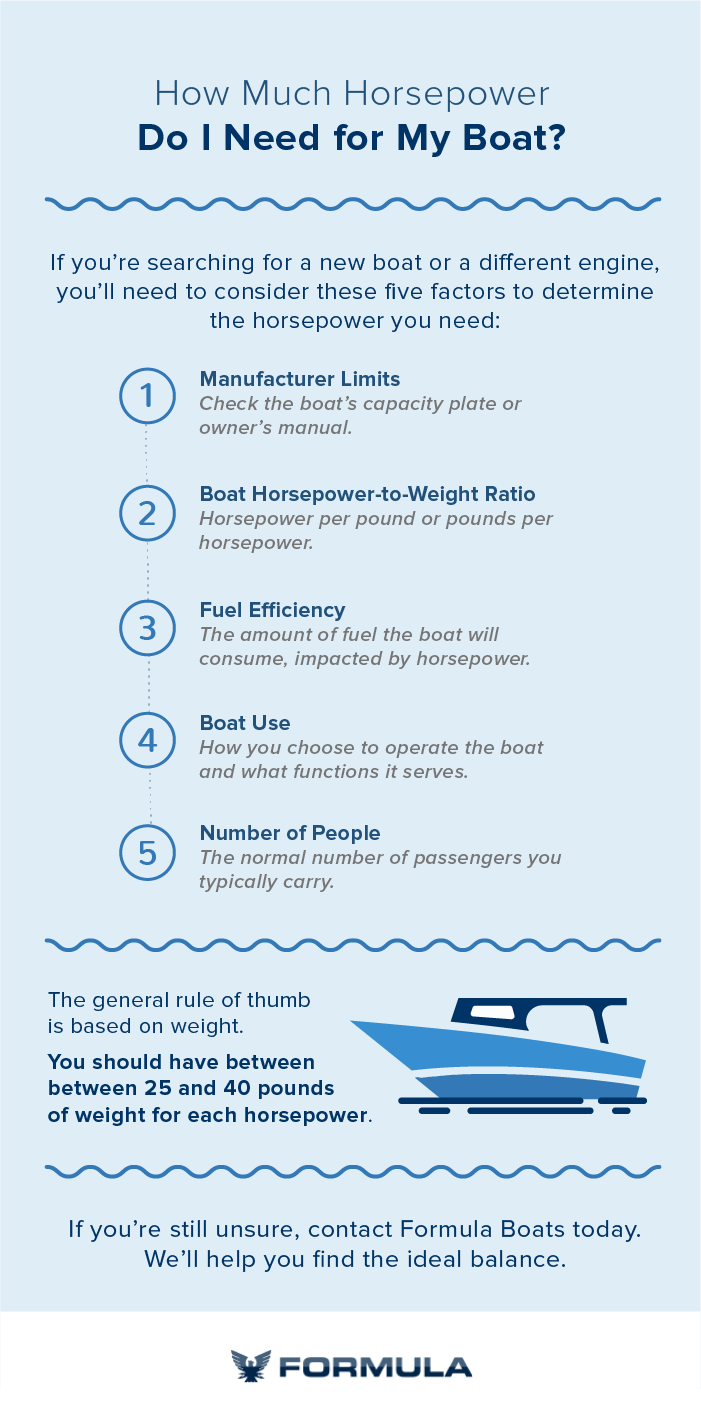
Manufacturer Limits
The easiest place to start is with the boat’s capacity plate — or owner’s manual. In addition to giving you a maximum for passengers and cargo, the manufacturer will also spell out the absolute maximum boat horsepower. If you have a boat that was built before 1972, came from overseas or was home-built, you may not have a capacity plate, but boat owner’s manuals are often available online. If not, you can always contact the boat’s manufacturer to inquire about their limits and recommendations for your particular boat model .
Boat Horsepower-to-Weight Ratio
When you’re trying to determine the amount of horsepower you need, it’s essential to consider the weight of the boat. The boat horsepower-to-weight ratio is simple to calculate and can be expressed in horsepower per pound or pounds per horsepower.
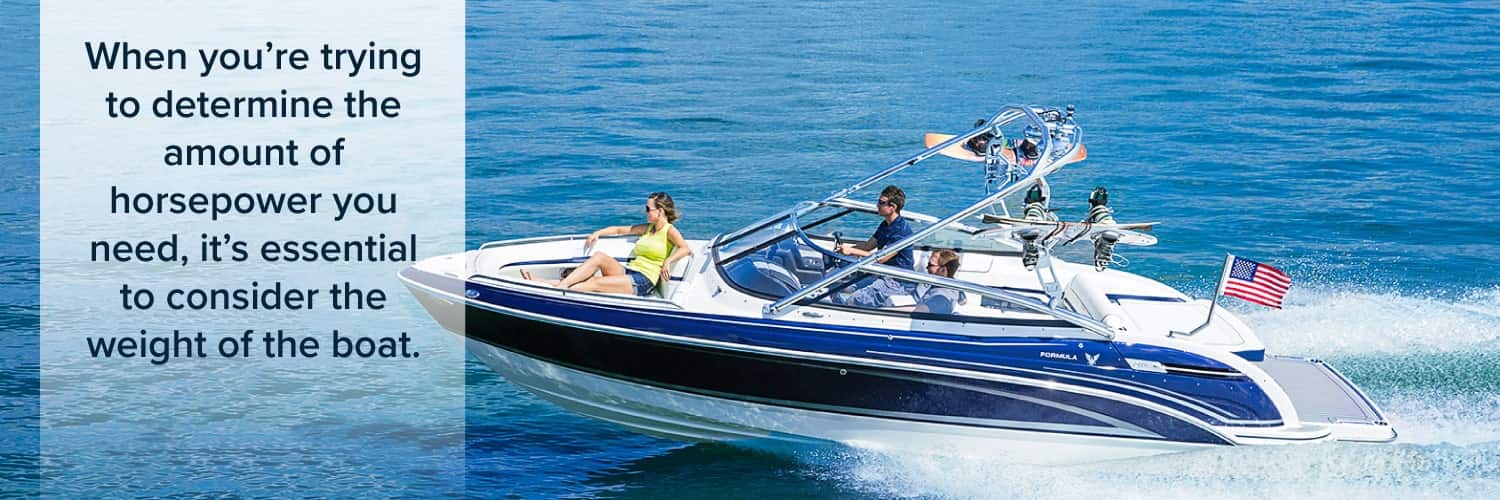
Let’s say, for example, your boat weighs 5,000 pounds, and it has a 300-horsepower engine. Taking 5,000 divided by 300 gives you a result of 16.6 pounds per horsepower. Doing the opposite calculation — taking 300 divided by 5,000 — gives you a result of 0.06 horsepower per pound. The lower the number, the faster your boat will go. Remember the boat horsepower-to-weight ratio once you’ve decided on horsepower and are matching outboard to boat size. While one or two outboards may give you the same horsepower result, keep in mind additional weight will accompany each additional outboard motor.
Fuel Efficiency
The amount of horsepower you choose will impact your fuel efficiency. However, just because you have a higher-horsepower engine does not necessarily mean you’re going to use more fuel. According to Boating magazine , running your gas engine between 3,000 and 3,500 rpm and your diesel engine at three-quarters throttle is the sweet spot for fuel efficiency. If you’re running a lower horsepower engine at full throttle all the time, it’s going to use more gas than a higher horsepower with less throttle. Keep this fact in mind as you consider what horsepower to choose.
For those who prefer exact calculations, Boating magazine has provided some calculations you can use to run some of the numbers. You’ll be calculating the gallons of fuel that are burned per hour (GPH). To do this, you need to know gasoline weighs approximately 6.1 pounds per gallon, while diesel weighs about 7.2 pounds per gallon. You also need to know a well maintained four-stroke gasoline engine is estimated to burn about 0.5 pounds of fuel per horsepower per hour, while a similar diesel engine is estimated to burn 0.4 pounds of fuel per hour.
The equation is GPH = (specific fuel consumption x HP)/fuel specific weight. For example, if you want to determine the fuel consumption for a 300-horsepower gasoline engine, you would calculate (0.50 x 300)/ 6.1, giving you a result of 24.5 gallons per hour.
As with most decisions related to boating, the use of the boat is always a factor. Are you using the boat just to cruise with friends and family ? Or will you be pulling water skiers, wakeboarders and tubers ? The addition of pulling someone behind the boat — and the additional weight of storing watersport accessories — increase the need for power and are often a reason to consider adding horsepower to your boat.
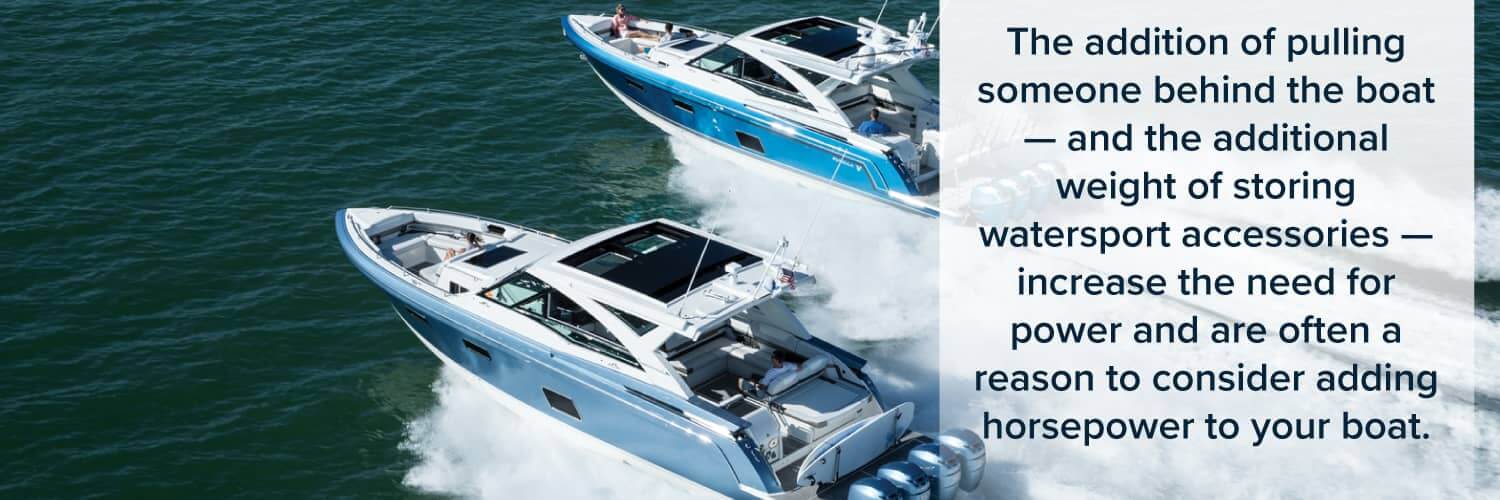
Number of People
Once you’ve considered the use of your boat, the next question to ask is what the normal number of passengers for your boat will be. If it’s usually just you and a friend or a spouse, that weight is different than if you enjoy boating with several of your family members and friends.
Rule of Thumb
If you’re the type of person who doesn’t need precise calculations — or just doesn’t want to be bothered with them — the Boat Trader blog offers a rule of thumb to use when determining the amount of horsepower for your boat. The rule of thumb is based on weight alone, and says you should have between 40 and 25 pounds of weight for each horsepower.
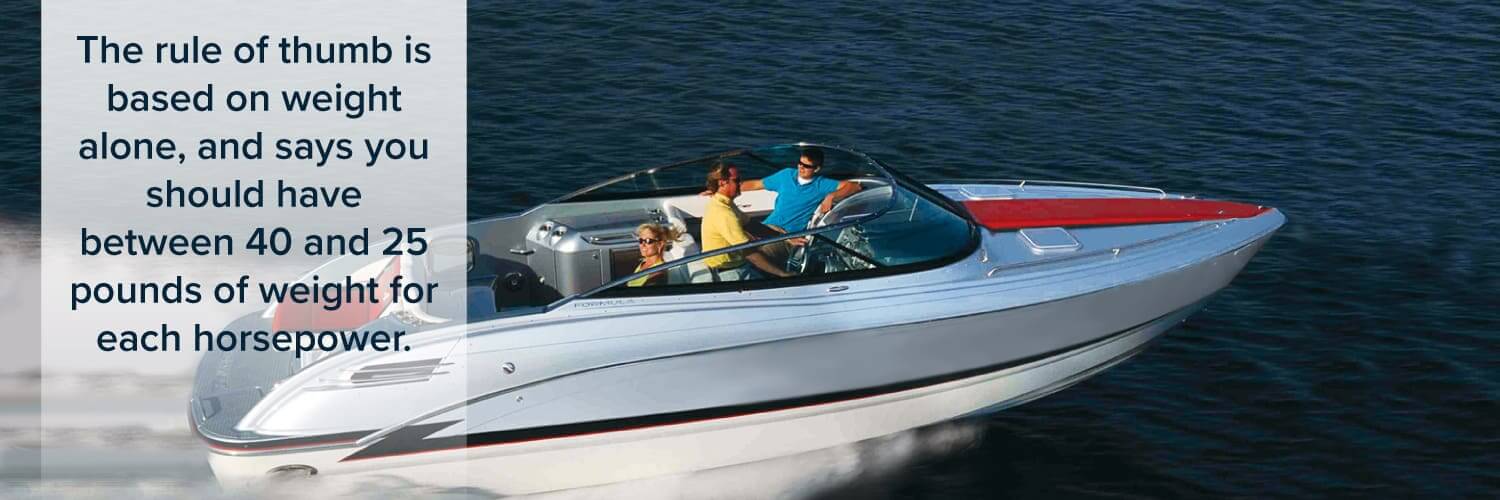
For example, a 5,000-pound boat could have an engine with between 125 and 200 horsepower. Yes, the range is wide, but that’s because boats have a variety of different designs and handle differently. While this rule of thumb can be a helpful way to get a ballpark range, it still requires some guesswork when it comes to considering your boat handling.
Federal Regulations
Is it illegal to overpower a boat? According to the federal government, yes. There are a few different ways you can define overpowering a boat. The horsepower capacity section of the Code of Federal Regulations contains its definition of overpowering a boat.
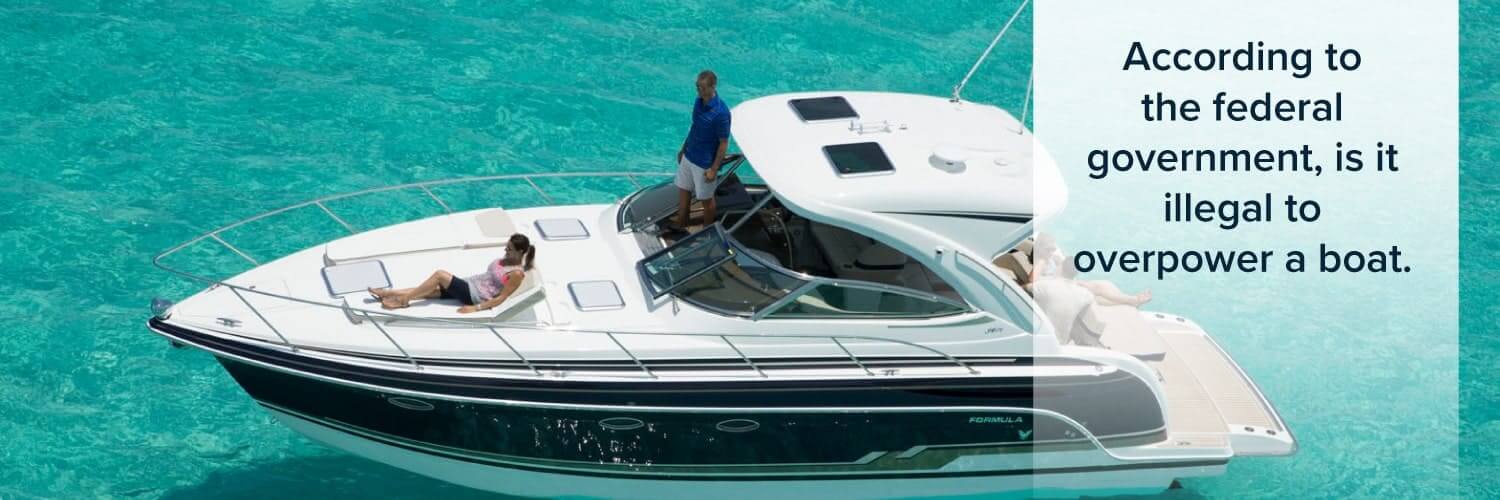
There are two different ways the federal government uses to determine the maximum horsepower for any given boat — one is a computation, and the other is a performance test. The way that is used depends on the boat. For the majority, the computation method is best to use. You multiply your boat length by the transom width. Then you take that number, which is known as the “factor,” and match it to a horsepower capacity according to the Code of Federal Regulations Table 183.53 — Outboard Boat Horsepower Capacity, shown below.
Don’t forget to adjust the result based on remote steering, transom height and boat bottom.
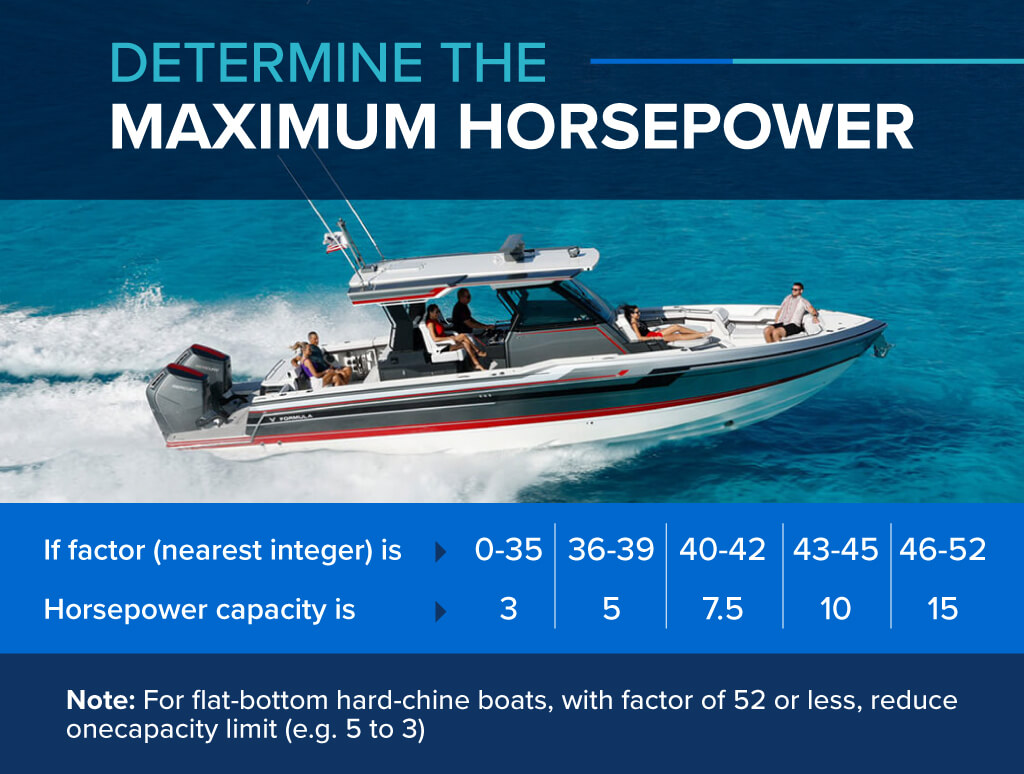
The performance test method is for boats that are 13 feet or less in length, have remote wheel steering, have a maximum capacity of no more than two persons and at least a 19-inch transom height — or at least a 19-inch motorwell height and at least a 15-inch transom height. Through this method, there are very specific instructions for boat preparation addressing everything from motor mounting to fuel tanks to ensure consistency. There are equally as specific instructions for the conditions in which you can perform this test.
The first part of the performance test is the quick-turn test. Setting the throttle at a low maneuvering speed and facing straight ahead, you then turn the wheel 180 degrees in half a second or less and hold it there. If you can complete the 90-degree turn without losing control of the boat or reducing the throttle, your boat has passed the test. Repeat, increasing the turn in speed until you can no longer pass the test, or you reach the maximum throttle. The maximum horsepower the boat can use while still completing this test is defined as the maximum horsepower capacity, unless it is more than 40 horsepower, in which case, the maximum horsepower capacity is capped at 40.
The good news is, these rules are in place for boat manufacturers, so assuming your boat’s manufacturer is following the federal regulations, you can consider the maximum horsepower capacity listed on your boat meets the federal regulation for its maximum horsepower.
Insurance Considerations
The amount of horsepower your boat has will influence your boat insurance, which is another fact to consider. There are three main areas of insurance the amount of horsepower you choose for your boat will affect — overall coverage, premium cost and type of policy.
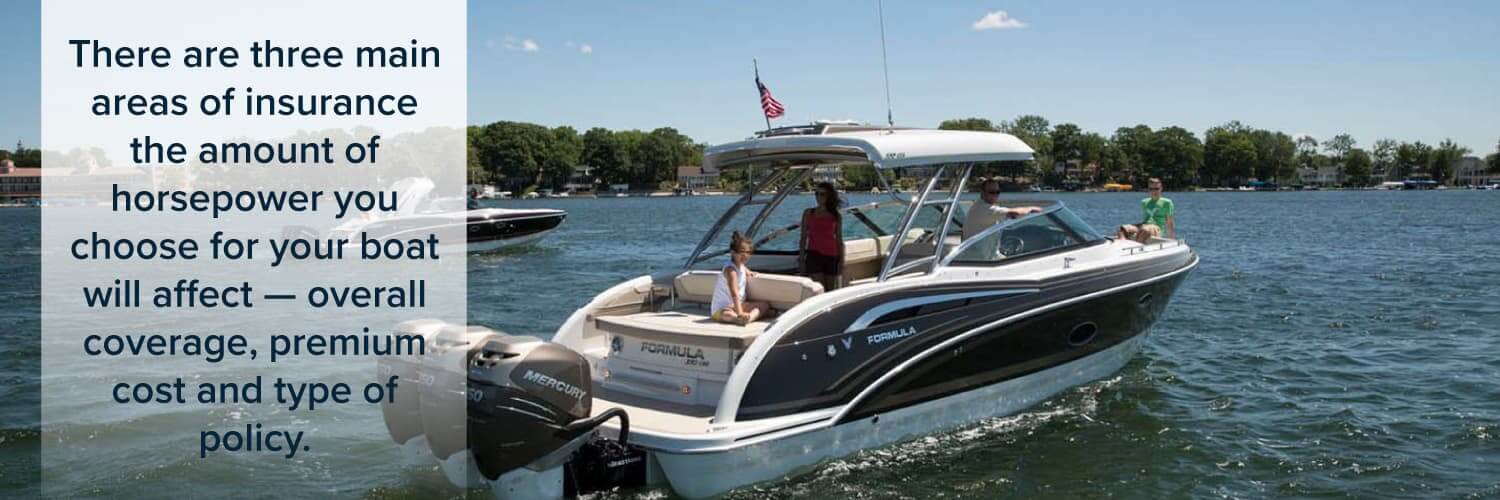
Overall Coverage
There is also a chance your insurance company will not cover a vessel that exceeds the boat manufacturer’s max horsepower. This is an extremely important factor, as it could affect your ability to get insurance coverage for your boat. If your boat is currently insured and you’re considering a motor upgrade, make sure you know your insurance company’s rules for horsepower limits. If you upgrade without abiding by these rules and notifying your insurance company, there’s a good chance they won’t cover any claim you file.
Premium Cost
While abiding by your insurance company’s rules for boat horsepower, it’s important to remember that doesn’t mean a change in horsepower won’t bring a change in your premium cost. As a rule of thumb, boats with higher horsepower will be more expensive to cover.
Type of Policy
In addition to solely considering the horsepower of the boat, the overall size of the vessel, which takes horsepower into account, may determine the type of boat insurance policy you need to get. For example, your homeowner’s or renter’s insurance policy will usually cover smaller powerboats with less than 25 horsepower. Boats that are larger and have more than 25 miles per hour horsepower almost always require a separate boat insurance policy.
Dangers of Overpowering Your Boat
Bigger and faster is not always better. Putting more horsepower behind your boat may seem like an innocent way to add some excitement to your boating experience, but it could cost you a significant amount of money in fines, lawsuits and damage to your boat. Here are a few examples of how your need for speed can get you in trouble when it comes to boat maximum horsepower.
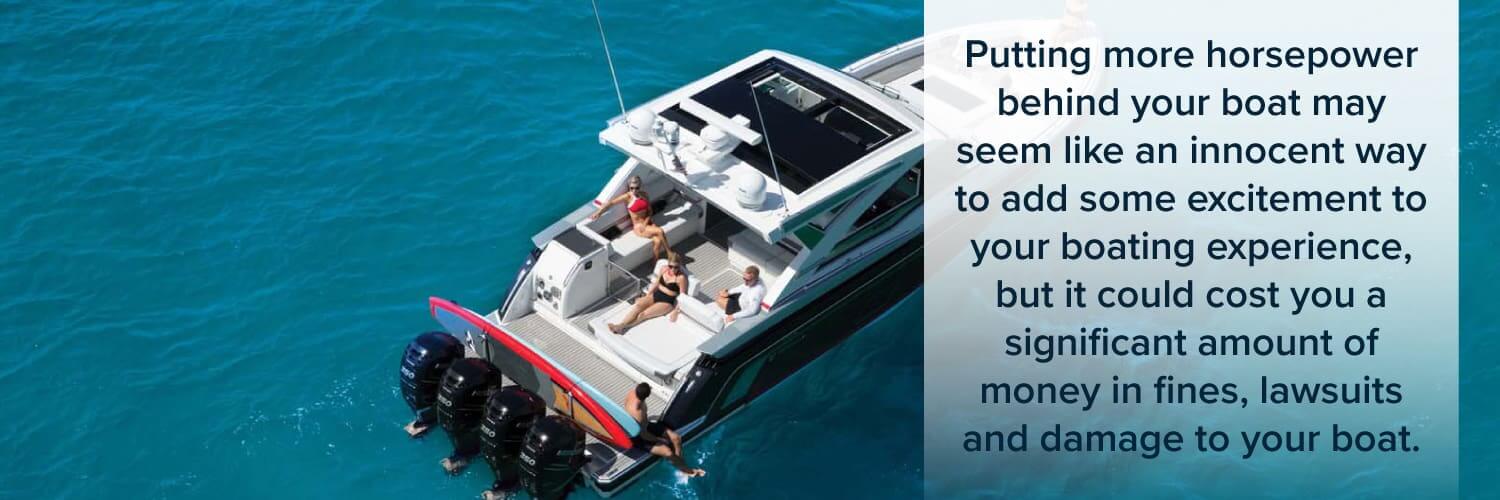
Breaking the Law
Is it illegal to overpower a boat? In some cases, yes. There are federal laws in place to ensure the appropriate horsepower limits are listed on all boats. State and local laws regarding overpowering your boat vary. Make sure you know the state and local laws for the areas in which you’ll be boating. Otherwise, your excess horsepower may be putting you at risk for fines and other consequences.
Accident Lawsuits
Even if your state and local laws don’t address overpowering your boat, you’re still putting yourself at risk in other ways. If you’re in an accident, the fact that your boat’s horsepower is above and beyond the manufacturer’s recommendations will be in the accident report. While you may not have fines because of breaking state and local laws, you are very susceptible to being found negligent and the victim of a lawsuit, especially in a case where there are damages.
Too Much Weight
In recent years, more horsepower hasn’t always meant more weight. However, it is still true in some cases, and that additional weight is another component of high horsepower that can be dangerous. For example, the additional weight can make a self-draining cockpit useless, leading to flooding problems.
Boat Damage
Even with additional horsepower that doesn’t add weight to the boat, the additional speed applies pressure that can cause significant damage to your boat. Every part of your boat, from the transom to the bow, was created to withstand a certain amount of pressure and stress. If you decide to ignore the boat’s maximum horsepower and overpower it, you’re exposing every part of your boat to pressure above and beyond what it was designed to endure, risking significant damage to the hull of your boat.
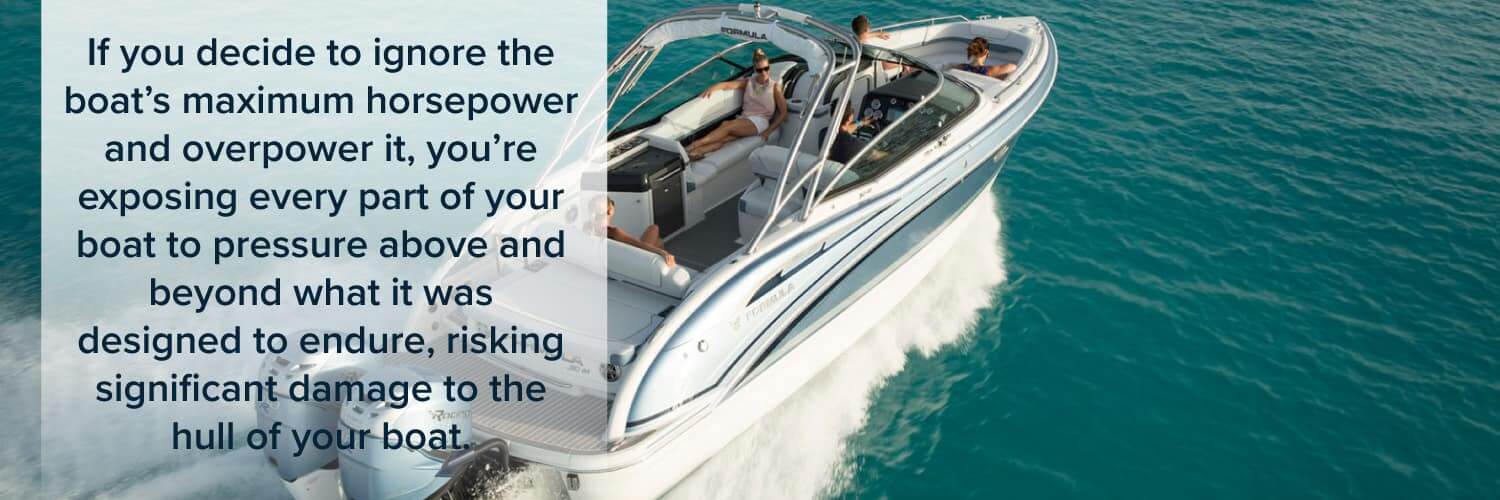
Finding a Boat With the Ideal Balance
As a boat manufacturer, at Formula Boats we know the balance of giving you the power and speed you want while making sure safety is a priority. If you’re considering purchasing a boat, our online boat builder gives you the opportunity to fully customize several different boat models with a few different horsepower options. You can be sure horsepower options for each boat model we provide are within the limits we believe maximize your performance while maintaining safety.
Discover a boat you like through our boat builder? We have dealers located throughout the country ready to help you find your boat. Get started by searching for the dealer location closest to you on our website.
Even though we narrow down the options, it can still be tough to choose the amount of horsepower that will give you performance based on boat weight and use, but also fuel efficiency. If you’re interested in one of our boat models, but are still wondering how much horsepower you need, we’re here to help — please don’t hesitate to contact us .
Contact Dealer
This site is protected by reCAPTCHA and the Google Privacy Policy and Terms of Service apply
- 2024 BOAT BUYERS GUIDE
- MIAMI BOAT SHOW
- Email Newsletters
- Fishing Boat Reviews
- Fly Fishing
- Marine Electronics
- Fishing Tackle
- Fishing Destinations
- The Bahamas Fishing Guide
- Boating Safety

How Much Horsepower Does Your Boat Really Need?
- By Alan Jones
- September 4, 2023
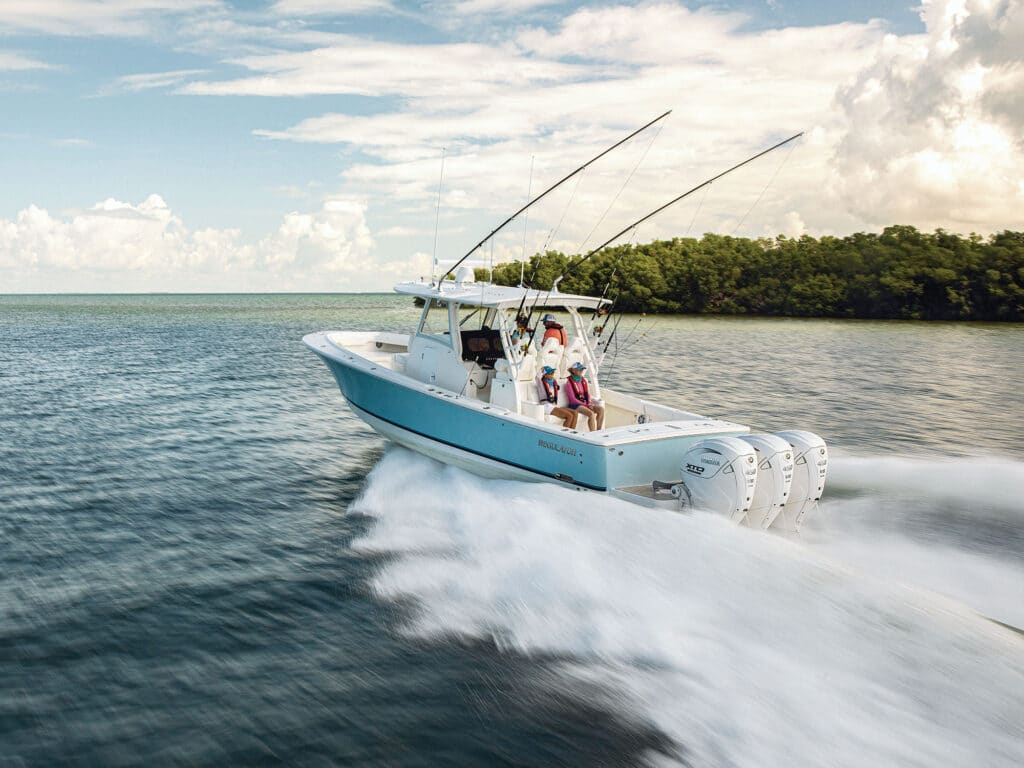
This could be the shortest column in marine journalism history. “To determine how much horsepower to put on your boat’s transom, find the manufacturer’s maximum horsepower specification, and whatever number is listed there is the total power to install.” While that’s a good rule of thumb, there might be times when less is more.
Go for the Max?
One good reason to get the most power possible lies in durability and longevity. The greater the horsepower, the less an engine has to work to keep the boat on plane with greater efficiency. Let’s look at an example. The Pathfinder 2005 TRS with a Yamaha F115 will have to operate at 5,500 rpm to reach 36.5 mph and will get 3.5 mpg. Power the same boat with an F150 and it reaches 35 mph at 4,500 rpm and will get 3.9 mpg, according to the manufacturer-supplied performance data. This example also illustrates that the notion that less horsepower equals better fuel economy isn’t always true. Top speed is another reason to max out the ponies. More horsepower translates to a higher top speed. Sometimes the difference is dramatic. A Sundance FX19 flats boat with a Yamaha F90 will reach 41 mph, but it’s a 60 mph boat with an F150. Then there’s the resale value. If a buyer is looking at two identical boats and one has more power than the other, they will typically choose and often pay more for the more powerful boat.
Mo’ Power, Mo’ Money
Often, taking even a small leap in power can cost big bucks. The standard engine on the Blackfin 232DC is the Mercury 225XL FourStroke, but bumping it just 25 hp to the Mercury 250XL will cost $4,921 more. In this case, the big jump comes by moving from the 3.4L family of V-6 engines to a 4.6L V-8 for the 250. When reviewing the build-a-boat feature found on most manufacturers’ websites, compare the cost with different engines and look for the sweet spot where the least amount of money buys the biggest jump in horsepower. Often, the max-power option is an exotic engine that comes with a larger-than-proportional price tag.
Read Next: How Much Fuel Capacity Do I Really Need?
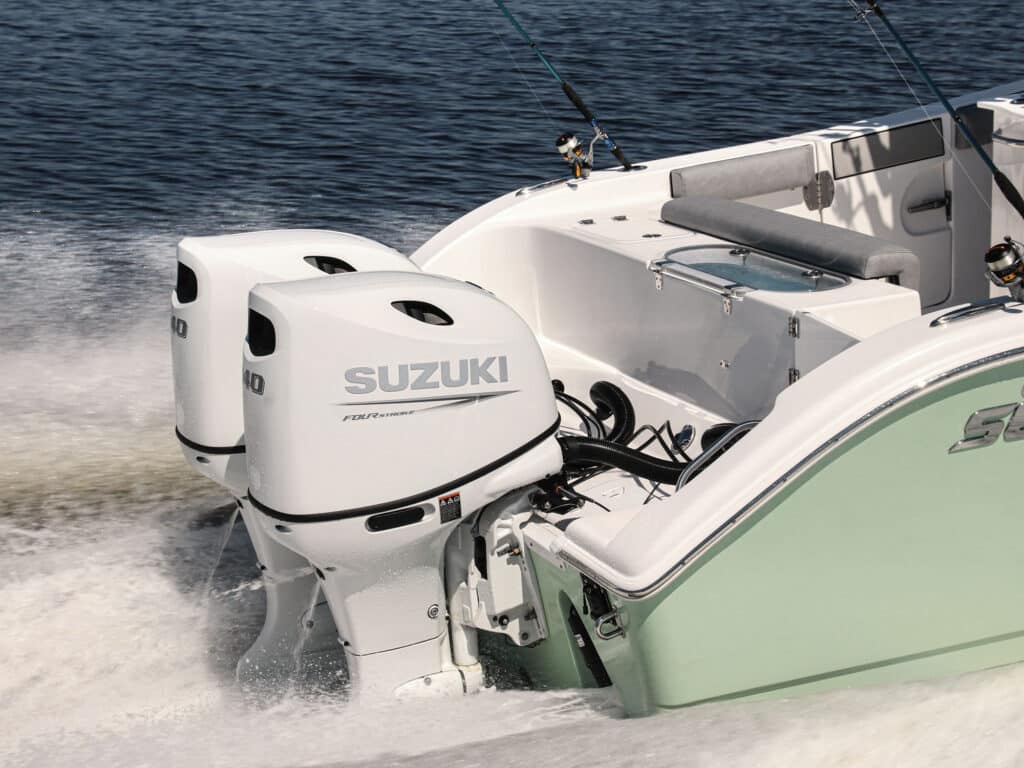
Less Power Equals Less Weight?
Sometimes, adding more horsepower changes the weight drastically, but an increase in horsepower often adds no weight because it is done via programming the engine’s electronic control unit. For years, Mercury’s supercharged Verados all shared the same 2.6L inline-six-cylinder block, even though the horsepower could range from 200 to 400, with a weight difference of just 38 pounds.
In the case of the Mercury 225XL V-6 versus the 250XL V-8, the weight difference is 52 pounds, which might not seem like much but could be significant on a small flats boat. Using multiple engines just exacerbates the difference.
Moving to the largest engine can make a huge difference. Mercury’s new Verado 600 is a 7.6L V-12 behemoth with a host of technological advances, but it also weighs 1,260 pounds. Yamaha’s XTO Offshore 450 V-8 weighs 988 pounds. In comparison, the Mercury 450R weighs just 689 pounds. Although more weight can cause slower hole-shot times, often this is counterbalanced by the additional horsepower and the larger prop that a higher-horsepower engine can swing. Need an example? Take a look at the Mercury Verado 600 V-12 that turns a massive 18-inch-diameter prop.
Horsepower needs also change if only one or two people routinely use the boat. If you typically invite a crowd of friends to go fishing, powering up to the max might make more sense. Otherwise, the boat can be sluggish and slow to respond to the throttle.
Variables Matter
If a boat weighs more, it’s probably going to need more power, but factors such as the hull design also matter. A Carolina Skiff 21 SWS is a 21-footer that features a relatively flat hull bottom, weighs 2,351 pounds, and has a maximum horsepower rating of 150. The Regulator 23 has a steep 24-degree transom deadrise to help it slice through ocean waves and weighs 6,700 pounds with a single outboard. The smallest outboard you can buy it with has 300 hp.
If a boat has a transom deadrise of 20 degrees or greater and is run in waters that can get rough, err on the side of more power. During situations like running through a ripping inlet, having crisp throttle response is often needed to safely transit out or return.
If you’re not sure about how much power to choose, talking to a local dealer is a good idea. They have the experience with and information on the models they sell that can help you make the best possible decision when it comes to the question of, “How much horsepower do I really need?”
- More: 2024 Boat Buyers Guide: More Resources , Boat Engines , Boats , October 2023 , outboard motors
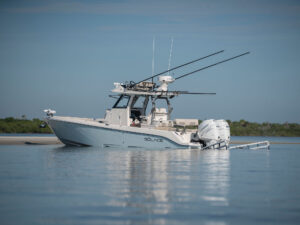
Win the Solace 30HCS in the 2024 Ultimate Boat Giveaway
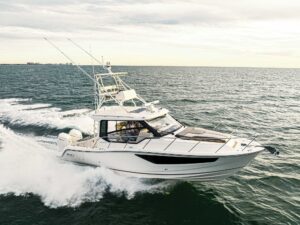
Boston Whaler 365 Conquest
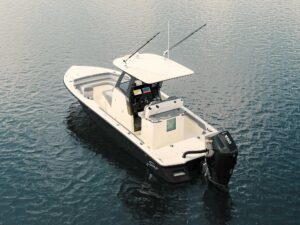
Scout 261 XSS
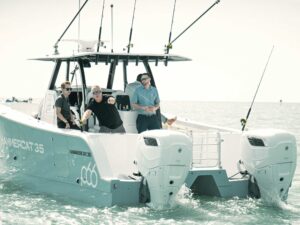
Cox 350 Diesel Outboard
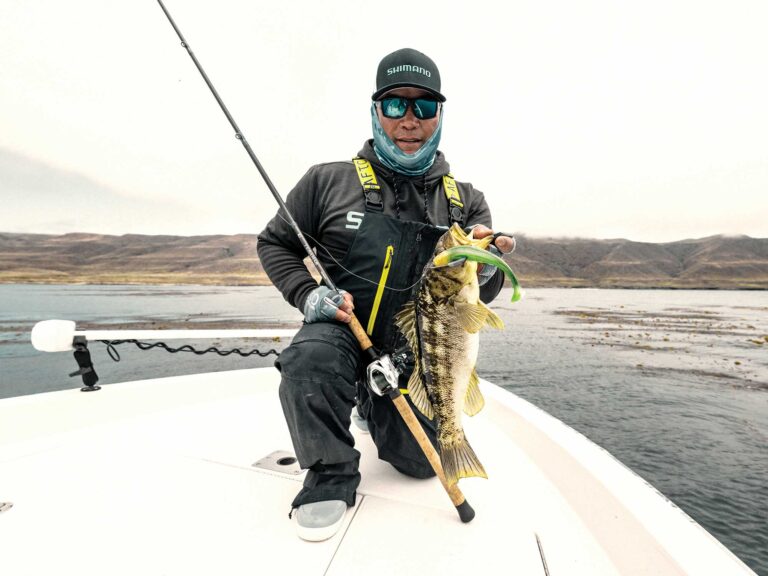
Using Weedless Baits to Catch Calico Bass
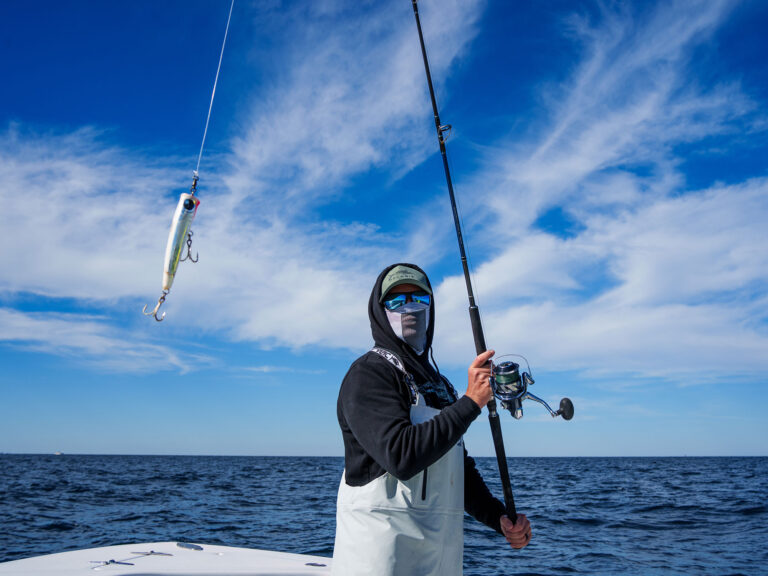
Popping for Tuna
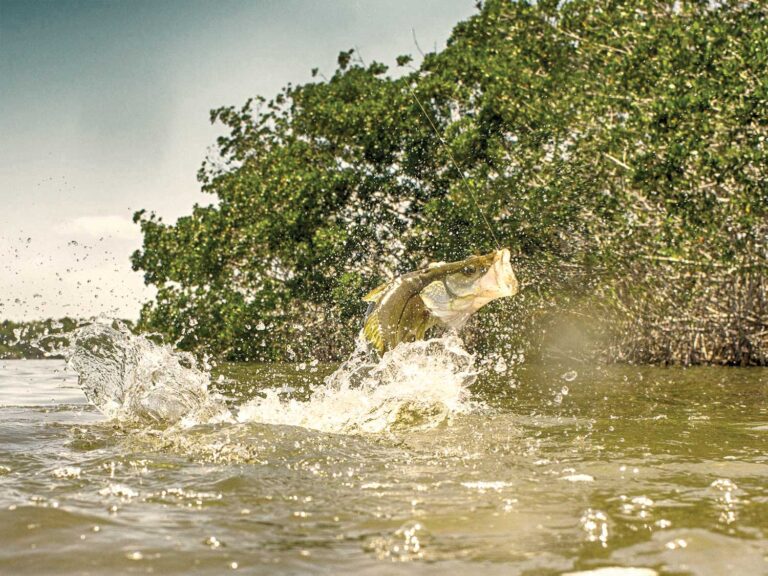
Fun Fishing at the Historic Flamingo Lodge
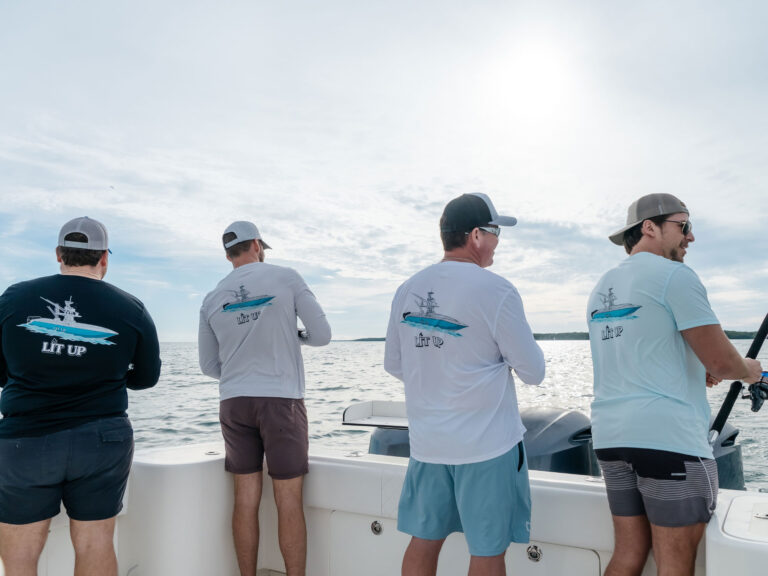
The Mission to Make Custom Boat Gear Convenient, Easy & Fun

- Digital Edition
- Customer Service
- Privacy Policy
- Cruising World
- Sailing World
- Salt Water Sportsman
- Sport Fishing
- Wakeboarding

Maximum Boat Horsepower Calculator
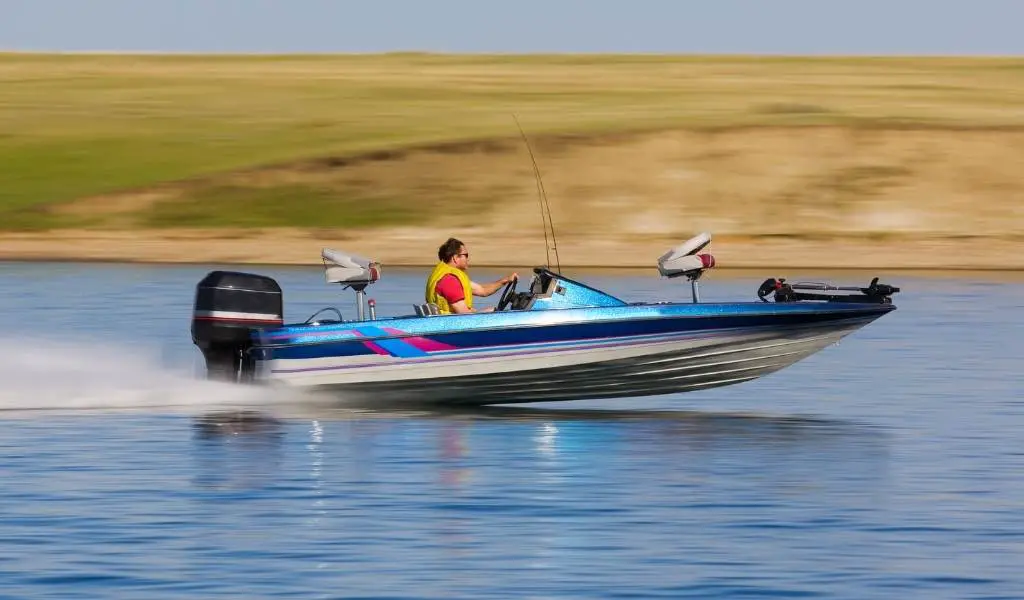
If you’re curious to know what the largest engine you can legally put on your boat is, try this calculator. It uses the federal regulations to compute the largest outboard engine you’re allowed to install.
The federal government regulates the horsepower of outboard motors that can be installed on boats. The maximum HP is determined by calculating the boat’s factor (the length multiplied by the width) and then looking up the allowable engine size in a table.
STEP ONE: Work Out Your Factor
Step two: convert factor to maximum horsepower, federal regulations about maximum horsepower, calculation method, manufacturer limits, the final word, horsepower calculator.
This step-by-step calculator will help you work out your maximum boat horsepower.
First, you need to workout your FACTOR, this is calculated using boat length and transom width. This calculator will help work out your FACTOR:
Using your FACTOR worked out above, you can find your maximum horsepower.
If the FACTOR is 52 or below, use this table:
If the FACTOR is 53 or more, use these calculations (round up to nearest 5):
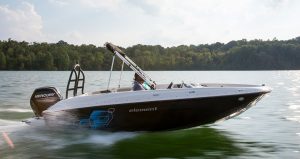
I’ve been playing around with the idea of putting a larger outboard on my boat , and decided to read the rules and regulations to see what’s allowed. The federal government has regulations for just about everything, so it should come as no surprise that they created one for the maximum horsepower capacity of your boat.
The Federal Regulations governing outboard motor horsepower capacity are listed in 33 CFR § 183.53 – Horsepower capacity . Feel free to read these regulations!
I did, and I discovered they are written in lawyerly language with a lot of exceptions and footnotes. Every time I found an outboard engine that interested me, I had to perform a tedious calculation and refer to the rules to see if it was legal or not. After a dozen or so times, I became very frustrated and decided to developed this tool. It makes the evaluation process extremely simple and eliminates some of the mistakes that I kept making.
Feel free to use this handy calculator to determine the largest outboard engine that is legal for your boat.
The federal government uses two methods for determining the largest engine allowable for your boat. One method is a calculation based on your boat’s dimensions and the other is a performance test. The calculator above uses the computational method. This approach calculates the “factor” for your boat that is spelled out in the rules. The factor is simply the length multiplied by the width of your boat. Based on this value, you lookup the maximum horsepower in a table. If you have a flat bottom boat, you’ll need to downsize the engine horsepower.
For large boats, there are a lot of special rules and things to consider. Each one of these factors results in an adjustment of the maximum allowed horsepower. Here are features your boat may have that will affect the allowable engine size:
- remote steering
- transom height
- boat bottom
Other Methods
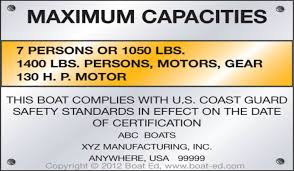
Most boats have a capacity plate that gives you a lot of information about your boat’s design capacity, including the maximum engine horsepower. If your boat was built after 1972 then it almost certainly has a National Marine Manufacturers Association Certification Plate. This plate lists the maximum motor horsepower that the boat designers built the boat to handle.
The capacity plate also lists the maximum number of passengers as well as the maximum weight your boat can safely carry. You can find this plate mounted near the helm.
If your boat doesn’t have a capacity plate or you can’t find it, you can likely find the information in the owner’s manual. Most manuals clearly state the maximum horsepower that the manufacturer deems safe and appropriate for your boat.
Don’t have the manual? Just call your boat’s manufacturer and ask. I’ve found the manufacturers to be very helpful. Every time I have a question about my boat, I’ve been able to get answer.
If you’re thinking about installing a bigger engine on your boat, you need to know what the federal regulations say. This calculator is a great screening tool to play around with, but it’s not meant to be a substitute for common sense or an expert’s opinion. You need to talk with a competent professional before making the decision about whether you can safely increase your boat’s power and how much. Talk to your mechanic and then contact your boat’s manufacturer to see what they say. The last thing you want to do is spend a lot of money only to create a safety hazard for you and your family.
Related Articles
What is the Best Outboard Motor for Saltwater How to Measure Your Outboard Motor Shaft Length Picking the Best Small Outboard Motor
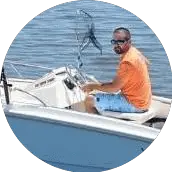
You Might Also Like
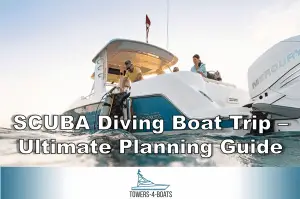
SCUBA Diving Boat Trip – Ultimate Planning Guide
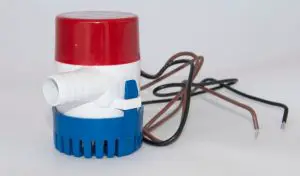
What Does a Bilge Pump Do?
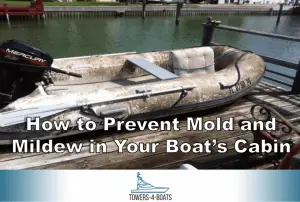
How to Prevent Mold and Mildew in Your Boat’s Cabin

How Much Horsepower Do I Need for My Boat?
So, you’re ready to dip your toes into boating, or maybe you already own a boat and are thinking of upgrading your boat’s horsepower.
There are a lot of different horsepower options available today, so it can be daunting to figure out how to make the right choice. In order to find the right horsepower that’s safe, efficient, and accomplishes your goals with your vessel, there are a handful of considerations you should keep in mind.
Let’s go over how to figure out how much horsepower you need for your boat. We’ll examine general guidelines, safety concerns, and how to decide based on your boat type and use. Lastly, we’ll go over cost considerations, as it’s something that’s usually on people’s minds when it comes to boats.
Table of Contents
The “Rule of Thumb ” for Boat Horsepower
Just to lay some groundwork, let’s briefly define horsepower . Horsepower is a common unit of power used for engines and motors. One horsepower is known to equal 33,000 foot-pounds of work per minute, or the electrical equivalent of 746 watts.
You don’t necessarily need to know all that, but it helps to understand the concept. Nearly all petroleum-powered (gasoline, diesel, etc.) boat engines, both inboard and outboard, are measured by horsepower.
The widely accepted rule of thumb for determining how much horsepower a boat needs is that you’ll need one horsepower for every 25-40 pounds of weight . The lower the ratio, meaning the more horsepower you have per pound, the faster the boat will go.
With that being said, this is a simplified equation. There are a variety of other factors you should consider, which we’ll explain in more detail next.

Is It Possible to Have Too Much Horsepower for a Boat?
Yes, it’s entirely possible to have too much horsepower for a boat. A boat with too high of horsepower can be too heavy and/or too fast, which ultimately results in a serious safety hazard.
It can also be illegal to overpower a boat with too much horsepower. At least in the United States, there are limits set by federal law regarding how much horsepower you can have based on the size and weight of your boat.
There also may be state and local regulations for how much horsepower you can have, so make sure to do your research for restrictions based on where you plan to go boating.
Is It Possible to Have Too Little Horsepower for a Boat?
While there’s no law that prevents anyone from having too little horsepower, there is such a thing as not having enough depending on the boat.
Not having enough horsepower for your boat will make getting around take longer, will use up fuel quicker, and in general, won’t allow you to achieve your boat’s full potential.
As with many things in life, a delicate balance will achieve the best results.
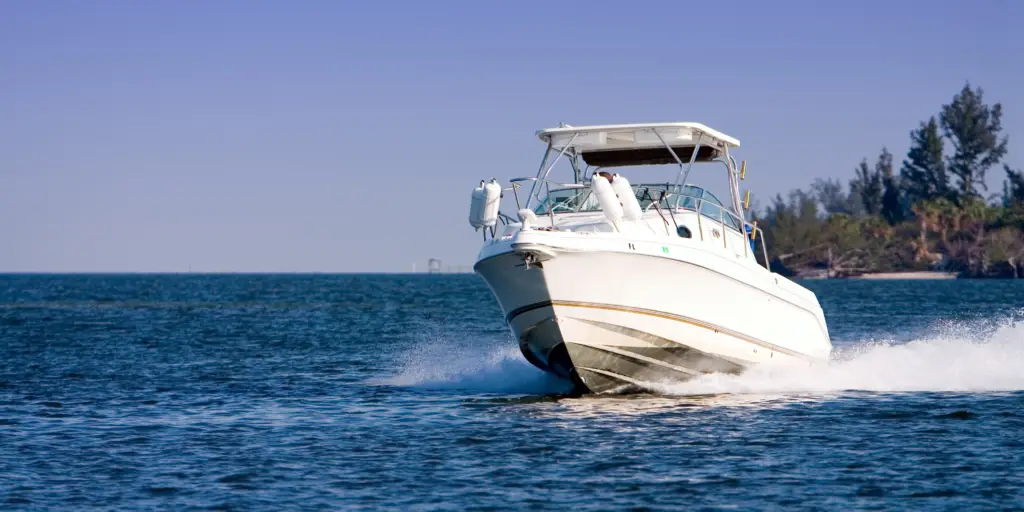
Manufacturer Limits/Guidelines
The first place you should start when trying to decide how much horsepower you need is your boat manufacturer’s guidelines or limits, specific to your exact boat model.
Every boat will have a horsepower limit listed in the owner’s manual and sometimes listed on a sticker on the boat itself. Boat makers take their designs through extensive performance and safety testing, so the horsepower limit they provide is well-informed. It’s highly advised that you never exceed your boat’s horsepower limit set by the manufacturer.
Exceeding a boat’s horsepower limit will cause performance issues, put additional strain on the boat itself, and cause safety issues. Going over the horsepower limit can also void warranties and increase your liability in the event of an accident.
Boat Weight
The weight of your boat is also a big factor in determining how much horsepower you’ll need. The heavier the boat, the more horsepower will be required to run it efficiently, and as we discussed earlier, you should aim for one horsepower for every 25-40 pounds.
When calculating the weight of your boat, make sure to take into account how much your boat weighs with a full tank of gas, gear, and the number of people you typically have on board. This will help inform a more real-world number for the amount of horsepower you’ll need.
The number of passengers is a big contributor to a boat’s loaded weight. Are you more of a solo boater? Well, you may be able to get away with a little less horsepower. Do you often take multiple people with you on your boating trips? A little extra horsepower may be worthwhile to help your boat operate more efficiently.

How you intend to use your boat and your goals for your boating trips can help you figure out how much horsepower you need as well. Higher horsepower engines will help you get around quicker and may be necessary for certain water sports.
Some boating uses where high horsepower is advantageous include:
- Watersports such as water skiing, wakeboarding, tubing, wake surfing, etc.
- Competitive fishing tournaments
- Long distance boating
On the other hand, your boat may simply not need a lot of horsepower to do what you want to do, such as pleasure boating or cruising. If you enjoy the simple pleasure of taking your boat out with friends and family to enjoy the sun and water, you can get by just fine with less horsepower.
Budget Considerations
Finally, one more thing you should not overlook when choosing how much horsepower you need for your boat is your budget.
With all of the many expenses associated with boats, the engine and engine maintenance are often the biggest expense. It’s nearly always the case that the more horsepower an engine is, the more it costs. If you’re trying to budget a boat build or upgrade, one of the simplest ways to cut costs is by opting for less horsepower.
Not only do high horsepower engines cost more and use up more fuel, but your boat insurance rates may increase, as well as your coverage limited. High horsepower is associated with higher liability, so it may be difficult to get affordable and comprehensive boat insurance with more horsepower.
There are many factors that go into choosing the right amount of horsepower for your boat. Hopefully, these guidelines are helpful and take a lot of the guesswork out of the process.
Make sure to have the appropriate horsepower for the size and weight of your boat, and never exceed the horsepower limit set by the manufacturer. Aside from that, you’ll just need to decide how much power you may need or not need for the activities you enjoy on the water.
Above all, be safe and have fun on your next boating adventure!
- Recent Posts
- What Size Trolling Motor is Needed for a Pontoon Boat? - April 28, 2023
- The Best Kayak Seat Cushions to Help You Stay on the Water Longer - April 13, 2023
- The Best Pontoon Boat Rod Holders - April 12, 2023
Boat Speed Calculator
Table of contents
The boat speed calculator determines the top speed of a boat based on the boat's power and displacement . If you wonder how fast a boat can go, this calculator will help you answer that. The calculator also utilizes a constant known as Crouch constant which differs based on the type of the boat.
The formula for the top speed of a boat is used by designers to perform preliminary design analysis of the hulls. This helps in keeping the cost of building a boat in check (visit the boat loan calculator for more). Read on to understand how to calculate the speed of your yacht using Crouch's formula and to know how much horsepower do I need for my boat?
What is boat speed — Calculating using Crouch's formula?
The speed of the boat, in simple words, is how fast it can go. However, unlike land vehicles, this speed is not a ratio of distance and time. The speed of a boat having an engine to deliver P horsepower and displacing D pounds is written as:
where S is the boat speed and C is the Crouch constant. The above equation is known as Crouch's formula.
Note: The formulation and value for the Crouch constant are specific for units such as the speed in miles per hour and displacement in pounds.
💡 Our tools can convert units automatically, but if you'd like to learn how to do these conversions yourself, then our speed conversion and torque to hp calculator could come in handy!
What is displacement?
The displacement for a boat is defined as the volume of water displaced . The volume is then converted to weight. This property of a ship is an application of Archimedes' principle . In other words, the displacement of a boat is its weight. This weight is usually measured in tonnes or pounds. For instance, a modern US Navy Gerald R. Ford-class aircraft carrier displaces about 100,000 tons at its full load, whereas a 17th-century fishing boat displaces only about 13 tons. The tonnage of the ship varies as per its class and purpose.
Keep reading about Archimedes' principle at our Archimedes' principle calculator and find out if an object sinks or floats in a liquid!
Crouch constant
The Crouch constant depends on the type of boat . The constant is applicable to a wide variety of boats, from runabouts to high-speed racing boats. It does not take the hull length into account. The table below has the value of the Crouch constant for different types.
How to calculate boat speed using this calculator?
Follow the steps below to calculate boat speed:
Step 1: Enter the shaft horsepower value, P .
Step 2: Insert the boat's displacement , D .
Step 3: Choose the Crouch constant , C from the list of boat types , or you can directly enter the value.
Step 4: The boat speed calculator will now return the value of boat's top speed.
Example of using the boat speed calculator
Calculate the speed of a racing hydroplane having an engine that delivers 3000 hp and displaces 6800 pounds of water.
To calculate boat speed :
Step 1: Enter shaft horsepower value P = 3000 hp .
Step 2: Insert the boat's displacement , D = 6800 lbs .
Step 3: Choose the Crouch constant , C from the list for hydroplanes, i.e., C = 220 .
Step 4: Using the Crouch's formula: S = √(P / D) × C = √(3000 / 6800) × 220 = 146.13 mph i.e., the speed of the hydroplane is about 146.13 miles per hour.
Alternatively, you can also run this calculator backward to know how much horsepower I need for my boat to achieve a certain speed. Say you want a top speed of 150 miles per hour for your 6,000 lb hydroplane. You can then:
Step 1: Enter top speed value S = 150 mph .
Step 2: Insert the boat's displacement , D = 6000 lbs .
Step 4: The calculator will use Crouch's formula to return the horsepower value as: Power = (P / C)² × D = (150 / 220)² × 6000 = 2789 hp
Therefore, you need an engine to deliver about 2800 hp to take your boat as fast as 150 mph .
How do I calculate a boat's top speed?
To calculate the boat speed:
Divide the power delivered by the boat to the displacement.
Find the square root of the result from step 1.
Multiply by the Crouch constant.
S = √(P / D) × C
What is Crouch's formula?
Crouch's formula is the equation to find the top speed of a boat based on its power P and tonnage D . The speed of the boat, S is given by the equation.
What is the value of Crouch's constant for a racing boat?
A racing boat has the value of Crouch constant around 210 .
What is the value of Crouch's constant for runabout boats?
An average runabout has the value of Crouch constant around 150 whereas it can go up to 190 for high-speed runabouts .
Shaft horsepower (P)
Boat displacement (D)
Crouch's constant (C)
Hitch-up to 6 Speed Boating Lakes in PA
Forget smooth rides and tranquil waters: some travelers have the need for speed — and rapids! Don’t get us wrong, we love a good picnic and can’t resist the chance to cast a fishing line, but adrenaline wins every so often. This summer, practice your water skiing, hold onto your inner tube, and kick it up a notch at some of the best boating lakes in PA just made for powerboating.
Don’t forget to have your boat registered with the PA Fish & Boat Commission . Out-of-state friends need not worry, it is legal to operate a boat registered in another state on Pennsylvania waters.
1. SHENANGO RIVER LAKE
Maximum Lake Speed: unlimited in portions
Shenango River Lake , one of the great western Pennsylvania lakes for boating, has six boat launch ramps located around the reservoir — an 11-mile-long stretch of water that accommodates powerboats of unlimited horsepower. Feed your need for an adrenaline rush when you try your hand at wakeboarding, water skiing, knee boarding, tubing, wake surfing, air chair, or wakeskating!
2. CURWENSVILLE LAKE
Maximum Lake Speed: no horsepower limitations
You’ll find Curwensville Lake in the Pennsylvania Wilds, but you won’t find any limits on horsepower. At the 790-acre lake, children 12 years of age or younger are required to wear a life jacket when underway on a boat that is 20' or less. Watercraft operators, passengers, sailboarders, water skiers or anyone being towed behind a boat must also wear a life jacket.
3. LAKE AUGUSTA
Located at the confluence of the west and north branches of the Susquehanna River, the 3,060-acre Lake Augusta is formed by the world’s largest inflatable dam. When the dam is raised in the summer, the real fun begins! The dam raises the water level at least eight feet and creates four miles of unhindered boating.
4. LAKE WALLENPAUPACK
Maximum Lake Speed: 45 miles per hour | no horsepower limitations
Speed and size — Lake Wallenpaupack in the Pocono Mountains is a massive 5,700 acres, 13 miles long, with 52 miles of shoreline, and 60 feet deep at its maximum depth. Jet skiing, wakeboarding, and water skiing are all up for grabs on these waters, so hold on tight!
5. RAYSTOWN LAKE
Maximum Lake Speed: no speed or horsepower limitations
Forget about the rules, because there are no horsepower or size restrictions for boats on Raystown Lake in The Alleghenies. This lake features 110 miles of underdeveloped shoreline as most summer homes weren’t built on the water. The shore is lined with trees, making for a unique scene while you cruise by on one of the most boat friendly lakes PA has to offer. Operated by the Army Corp of Engineers, Raystown is up to 200 feet deep.
6. BELTZVILLE LAKE
Maximum Lake Speed: 45 miles per hour
With a 19.8-mile shoreline and nearly 1,000 acres of open water, Beltzville Lake in the Pocono Mountains is the centerpiece of the state park and a hotbed of H2O happiness. Along the northern shore of the lake, visitors can use the three-lane boat launching ramp and dock. Boats are permitted to ride up to 45 miles per hour, so hold on tight — you’ll have plenty of room for waterskiing or tubing!
To learn more about lake vacations, check out the visitPA website . Follow us on Facebook , Twitter , and Instagram to stay up-to-date on even more great ideas and places to visit around our state. Don’t forget to sign up for our monthly PA travel e-newsletter so you never miss an update!
We use cookies to ensure that we give you the best experience on our website. If you continue to use our website, we will assume that you are happy to receive all cookies (and milk!) from visitPA.com. Learn more about cookie data in our Privacy Policy
You are using an outdated browser. Please upgrade your browser or activate Google Chrome Frame to improve your experience.
We Deliver To Your Door In Canada

24 hr Worldwide Shipping
Your cart will be saved on this device for 30 days.

From 8am - 5pm (USA - Est)

Parts Specialist
English - Español

Home | Blog | How Much Horsepower Do You Need for Your Boat?
How much horsepower do you need for your boat.
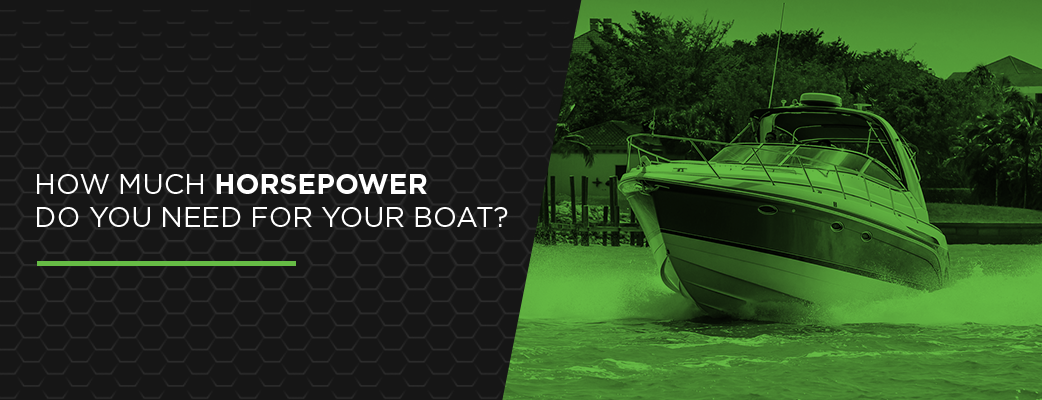
When you’re deciding how much power you want driving your boat, the obvious answer may be “as much as possible.” However, raw power doesn’t necessarily translate to capability. While a boat’s manual or capacity plate will state the maximum horsepower that can be safely harnessed to that vessel, jumping straight to that upper limit will yield diminishing returns.
When calculating boat horsepower needs, it’s best to consider your boat’s size, weight and intended use to inform your engine selection. A well-chosen motor setup will offer an optimal combination of handling, stability and performance.
Key Factors for Calculating Boat Horsepower
Once you’ve determined the maximum horsepower for your boat, you can work within that limit to choose an engine that suits your specific needs. When calculating boat horsepower, make sure to consider the following factors.
Speed and Fuel Efficiency
As speed is directly related to power, there is a simple equation that uses speed to determine a boat’s horsepower measurement: One unit of horsepower will move 40 pounds of boat weight at 20 mph. For a 2,000-pound boat to reach 20 mph, it needs 50 horsepower.
This relationship between speed and horsepower has a significant impact on fuel efficiency , as well, since diesel engines run best at three-quarters throttle and gas engines prefer the 3,000 to 3,500 rpm range.
Since a smaller engine running at its top range will be less efficient than a bigger one running comfortably, a primary consideration of how much horsepower you need for your boat is what you’ll be doing on the water.
If the same 2,000-pound boat is going to pull a skier at 36 mph, it will need 90 horsepower to reach that speed, and a 120 horsepower diesel engine would yield the best fuel efficiency. A pontoon boat built for pleasure cruises won’t have the same power requirements as a deck boat intended for water sports.
When calculating your boat’s horsepower needs, it’s also essential that you account for the weight of your passengers and gear, especially on larger vessels. Items like coolers, innertubes and fishing equipment can add up quickly, and you want to ensure the additional weight will not overtax your motor.
Multiple Engines
Put simply, horsepower is just a unit of energy, whether it is generated by one engine or three. Installing additional engines will increase your power requirements by adding to boat weight. However, this step can also improve efficiency by decreasing the amount of work performed by each motor.
The presence of multiple engines can also offer peace of mind, as in the unlikely event of a motor failing, you won’t be completely stranded.
Let Diesel Pro Power Determine Your Horsepower Needs
Many factors go into choosing the ideal engine for your boat, and maximum horsepower is only one of them. Diesel Pro Power wants every one of our customers to get the most out of their boats, and we are committed to providing the best customer service in the industry.
Diesel Pro Power has a massive inventory of marine diesel engine components , and Cummins engine parts , so we know how many options are out there when it comes to choosing a motor. If you’re feeling overwhelmed, one of our customer service experts would be happy to work with you to understand your needs and find a choice that fits your budget.
To simplify your engine selection today, visit the Diesel Pro Power help page or call us at 888-433-4735 in the U.S. or 305-545-5588 internationally.

IMAGES
COMMENTS
The greatest powerboats in the world - those that inspire movies and movie stars, the boats that are the most fun to drive, the boats that invite clusters of onlookers at the docks - are high-performance speed boats. ... Buyers can get inboard engines with horsepower that range to upward of 1,500-hp. Outboard power also has been making ...
Fountain Powerboats. Fountain 34 Thunder Cat. Image credit: Fountain Powerboats ... Thanks to Mercury Racing, modern outboard motors are more reliable than ever and are capable of extreme horsepower, including the renowned 450-horsepower, 4.6-liter V8 450R racing outboard engine that is steeped in Mercury Racing DNA, the newer 500R racing ...
A higher horsepower engine will give you greater top speed, while more torque will enhance your boat's acceleration and towing capabilities. Fuel options for powerboat engines - gasoline vs diesel. Choosing the right fuel option for your powerboat engine is an important decision that can impact both performance and maintenance.
Must follow navigation rules for powerboats ... The length, age of the boat, and of course the engine size and horsepower output will all affect the overall cruising speed and top speed. Generally speaking, any powerboat that can go 70 mph and above, are known as performance boats, with some of the top speeds clocked at 120 - 180 mph!
The heart of a powerboat is its engine, with horsepower (HP) ratings that can soar into the thousands for performance models. For instance, Formula Boats, known for their high-performance powerboats, equip their vessels with engines that can deliver upwards of 600 HP. High-powered engines ensure that propulsion and performance are maximized for ...
Class1 offshore powerboat. Offshore powerboat racing is a type of racing by ocean-going powerboats, typically point-to-point racing.. In most of the world, offshore powerboat racing is led by the Union Internationale Motonautique (UIM) regulated Class 1 and Powerboat P1. In the US, offshore powerboat racing is led by the APBA/UIM and consists of races hosted by Powerboat P1 USA.
Performance powerboats are built for speed, featuring narrow beam, steep deadrise, and high power to weight ratios. They have Spartan cabins. Cockpits seat 2-6 passengers. Powered by high horsepower outboards, stern drives or surface drives, these boats are carefully designed to be fast, light and strong, ideal for racing or fast cruising.
Each go-fast powerboat manufacturer offers a tested range of power for each model, and that means two or three reasonable, sensible choices. Hustler Powerboats, for example, will build its popular 29-foot V-bottom with a Mercury Racing 565, 540, or 520 engine. However, the good folks at the Calverton, N.Y. company will not —no matter how much ...
Nor-Tech 450 and 500 Sport Center Console: 2000 hp, 85 mph. With four Mercury Racing 450R outboards, the Nor-Tech Hi-Performance Boats 390 Sport center console—the Fort Myers, Fla., company's biggest seller—runs 90-plus mph. That's plenty fast for any center console, so triple 500R propulsion packages likely will be the best option for ...
They're all expensive—think £80,000 for an entry-level new go-fast powerboat. At the highest of the high end, something on the order of, let's say, a 50ft enclosed-cockpit, all-carbon-fibre catamaran with twin 3,000hp turbine engines and 200+ mph capability, you're looking at more than £650,000. In short, go-fast boats are not for the ...
Taking 5,000 divided by 300 gives you a result of 16.6 pounds per horsepower. Doing the opposite calculation — taking 300 divided by 5,000 — gives you a result of 0.06 horsepower per pound. The lower the number, the faster your boat will go.
These powerboats use the following propulsion options: stern drive, high-horsepower outboard engines or inboards. There are a wide range of High Performance boats for sale from popular brands like Skipper-BSK, Fountain and Formula with 1,142 new and 1,211 used and an average price of $120,114 with boats ranging from as little as $10,177 and ...
SEE THE BOATS. Fans may visit boats and their race crews from 9 a.m. to 5 p.m., Friday through Sunday, at the dry pit locations at San Pablo Catholic Church. Wet pits are located at Faro Blanco Marina and open to the public from 10 a.m. to 5 p.m. Saturday and Sunday. Reaching speeds of up to 140 mph, multiple classes of boats, including the ...
The Pathfinder 2005 TRS with a Yamaha F115 will have to operate at 5,500 rpm to reach 36.5 mph and will get 3.5 mpg. Power the same boat with an F150 and it reaches 35 mph at 4,500 rpm and will get 3.9 mpg, according to the manufacturer-supplied performance data. This example also illustrates that the notion that less horsepower equals better ...
In offshore powerboat racing, most boats fall under either a catamaran or a v-bottom, and typically these boats feature twin engines or a single engine. In some cases, these boats can have three or even four engines, but that setup is far more rare. In the Super Vee Lite class, the majority of boats are in the 30-foot range.
When it comes to sheer power, outboards simply can't match inboards. They're available in thousands of horsepower; come in both gasoline and diesel models (though when considering the models that out-size the largest outboards, diesel is the only option); and since they can be adapted to mate with many different propulsion systems they work well in a variety of different types of boats.
The calculator above uses the computational method. This approach calculates the "factor" for your boat that is spelled out in the rules. The factor is simply the length multiplied by the width of your boat. Based on this value, you lookup the maximum horsepower in a table. If you have a flat bottom boat, you'll need to downsize the ...
Nearly all petroleum-powered (gasoline, diesel, etc.) boat engines, both inboard and outboard, are measured by horsepower. The widely accepted rule of thumb for determining how much horsepower a boat needs is that you'll need one horsepower for every 25-40 pounds of weight. The lower the ratio, meaning the more horsepower you have per pound ...
Calculate the speed of a racing hydroplane having an engine that delivers 3000 hp and displaces 6800 pounds of water.. To calculate boat speed:. Step 1: Enter shaft horsepower value P = 3000 hp.. Step 2: Insert the boat's displacement, D = 6800 lbs.. Step 3: Choose the Crouch constant, C from the list for hydroplanes, i.e., C = 220.. Step 4: Using the Crouch's formula:
1. SHENANGO RIVER LAKE. Hermitage. Maximum Lake Speed: unlimited in portions. Shenango River Lake, one of the great western Pennsylvania lakes for boating, has six boat launch ramps located around the reservoir — an 11-mile-long stretch of water that accommodates powerboats of unlimited horsepower. Feed your need for an adrenaline rush when ...
Your Boat's Gross Load Capacity and Horsepower Recommendations. You must be aware of the federal regulations for your boat's engine power (horsepower) and gross load capacity (maximum weight). According to federal law, motorized boats that are less than 20 feet in length must have a capacity plate in the steering or helm area.
For a 2,000-pound boat to reach 20 mph, it needs 50 horsepower. This relationship between speed and horsepower has a significant impact on fuel efficiency, as well, since diesel engines run best at three-quarters throttle and gas engines prefer the 3,000 to 3,500 rpm range.
Be aware of the federal regulations for your boat's engine power (horsepower) and gross load capacity (maximum weight). According to federal law, motorized boats that are less than 20 feet in length must have a capacity plate in the steering or helm area. The capacity plate is where you can you find the maximum horsepower for your boat.